Liste sans doublons
Liste sans doublons triée 1 colonne et 2 colonnes
Liste des doublons
Suppression de doublons dans une colonne
Repérage des doublons
Repérer les doublons 2 colonnes
Fusion de lignes doublons
Suppression de doublons dans une BD
Suppression de doublons avec totalisation
Suppression doublons rapide avec Dictionary
Suppression doublons 2 listes
Fonction sans doublons d'une liste
Fonction liste sans doublons triée
Eléments communs à 2 listes
Comparaison de 2 listes de prix
Différence entre 2BD
Lignes qui existent dans BD1 et pas dans BD2
Liste des doublons et des valeurs uniques
Comparaison de 2 BD par MFC
Communs 2 BD par filtre élaboré
Comparaison de 2 BD:Modifications, communs, ajouts,
fusion
Lignes communes de 2BD (sur toutes les colonnes)
Coloriage des communs à 2 BD
Eléments communs à plusieurs feuilles
Comparaison sur arrondi de numérique
Fusion de 2BD
Fusion sans doublons de plusieurs BD
Fusion/Consolidation BD
Comparaison BD rapide
Compare les codes et pays de 2 BD
Repérage des doublons 3D
Elimine les doublons dans une cellule
Doublons dans une cellule
Suppression de lignes vides
Suppression de lignes
Fonction liste sans doublons triée multi-zones
Suppression de doublons multi-feuilles
Liste des villes en doublon
Extraction des doublons d'une BD avec le filtre
élaboré
Suppression de doublons avec totalisation
Fonction de suppression de doublons
Nombre d'occurences des doublons
Génère des identifiants
Liste sans doublons
0,26 sec pour 16.000 lignes
Set mondico = CreateObject("Scripting.Dictionary")
For Each c In Range("a2", [a65000].End(xlUp))
mondico(c.Value) = ""
Next c
[c2].Resize(mondico.Count, 1) = Application.Transpose(mondico.keys)
0,04 sec pour 16.000 lignes
Set mondico = CreateObject("Scripting.Dictionary")
a = Range("a2", [a65000].End(xlUp)).Value
For Each c In a
mondico(c) = ""
Next c
[c2].Resize(mondico.Count, 1) = Application.Transpose(mondico.keys)
Suppression de doublons dans une colonne
Supprime les doublons d'une colonne sans supprimer les lignes (0,1s pour 10.000 lignes).
SupDoublonsDansColonne
SupDoublonsPlusieursColonnes
Sub SupDoublonsColonne()
Set d = CreateObject("Scripting.Dictionary")
Set début = Cells(2, 2)
a = Range(début, début.End(xlDown))
For Each c In a
d(c) = ""
Next c
Range(début, début.End(xlDown)).ClearContents
début.Resize(d.Count, 1) = Application.Transpose(d.keys)
End Sub
Avec la méthode traditionnelle, la colonne doit
être triée.
Pour 10.000 lignes, le temps de suppression est >10s pour un taux de
suppression de 10%
Sub SupDoublonsColonneTradi()
Application.ScreenUpdating = False
Application.Calculation = xlCalculationManual
For i = [C65000].End(xlUp).Row To 2 Step -1
If Cells(i, 2) = Cells(i - 1, 2) Then Cells(i,
2).Delete Shift:=xlUp
Next i
Application.Calculation = xlCalculationAutomatic
End Sub
Liste sans doublons triée 1 colonne et 2 colonnes
A partir d'une liste avec doublons en colonne A, on obtient une liste sans doublons triée en colonne C.
ListeSansDoublonsTriée
FonctionListeSansDoublonsTriée
FonctionListeSansDoublonsTriée2
FormCascadeSansDoublons2colonnesDict
FormCascadeSansDoublons2colonnesTrié
FormCascadeSansDoublons2colonnesMAC
Version1
Sub SansDoublonsTrié1()
Dim temp()
Set f = Sheets("Feuil1")
Set mondico = CreateObject("Scripting.Dictionary")
a = Range(f.[a2], f.[a65000].End(xlUp)).Value
For Each c In a
mondico(c) = ""
Next c
Set dest = f.Range("C2")
dest.Resize(mondico.Count, 1) = Application.Transpose(mondico.keys)
dest.Resize(mondico.Count, 1).Sort Key1:=dest, Order1:=xlAscending
Set mondico = Nothing ' libère mondico
End Sub
Version2
Sub SansDoublonsTrié2()
Dim temp()
Set f = Sheets("Feuil1")
Set mondico = CreateObject("Scripting.Dictionary")
a = Range(f.[a2], f.[a65000].End(xlUp)).Value ' tableau
pour rapidité
For Each c In a
mondico(c) = ""
Next c
temp = mondico.keys ' dans un tableau pour tri
Call tri(temp, LBound(temp), UBound(temp))
f.[C2].Resize(mondico.Count, 1) = Application.Transpose(temp)
Set mondico = Nothing ' libère mondico
End Sub
Sub tri(a(), gauc, droi) ' Quick sort
ref = a((gauc + droi) \ 2)
g = gauc: d = droi
Do
Do While a(g) < ref: g = g + 1: Loop
Do While ref < a(d): d = d - 1: Loop
If g <= d Then
temp = a(g): a(g) = a(d): a(d) = temp
g = g + 1: d = d - 1
End If
Loop While g <= d
If g < droi Then Call tri(a, g, droi)
If gauc < d Then Call tri(a, gauc, d)
End Sub
S'il y a des Majuscules/Minuscules
MonDico(Ucase(c) )= ""
ou
MonDico(Application.Proper(c) )= ""
Liste des doublons
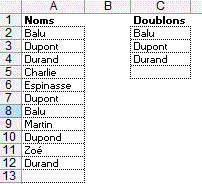
Sub ListeDoublons()
Set d1 = CreateObject("Scripting.Dictionary")
Set d2 = CreateObject("Scripting.Dictionary")
For Each c In Range([a2], [a65000].End(xlUp))
If d1.exists(c.Value) Then d2(c.Value) = ""
d1(c.Value) = ""
Next c
If d2.Count > 0 Then [c2].Resize(d2.Count, 1) = Application.Transpose(d2.keys)
End Sub
Liste des adresses des doublons
Doublons
Dupont $A$3-$A$7-
Balu $A$2-$A$8-$A$13-
Durand $A$4-$A$12-
Sub ListeDoublonsColA()
Set d1 = CreateObject("Scripting.Dictionary")
Set d2 = CreateObject("Scripting.Dictionary")
For Each c In Range([a2], [a65000].End(xlUp))
If c <> "" And d1.exists(c.Value)
Then d2(c.Value) = d1(c.Value) & c.Address & "-"
d1(c.Value) = d1(c.Value) & c.Address &
"-"
Next c
If d2.Count > 0 Then
[J2].Resize(d2.Count, 1) = Application.Transpose(d2.keys)
[K2].Resize(d2.Count, 1) = Application.Transpose(d2.Items)
End If
End Sub
Liste des doublons d'une BD avec le filtre élaboré
En E2:=NB.SI(B:B;B2)>1
Sub FiltreDoublons()
[A1].CurrentRegion.AdvancedFilter Action:=xlFilterCopy, CriteriaRange:=[E1:E2],
CopyToRange:=[G1:I1], Unique:=False
[G1].CurrentRegion.Sort Key1:=Range("I2"), Order1:=xlAscending,
Header:=lGuess
End Sub
Avec Dictionary
Sub ListeDoublons() 'rapide
Set f = Sheets("feuil1")
Set f2 = Sheets("feuil2")
Set mondico = CreateObject("Scripting.Dictionary")
For Each c In f.Range("b2", f.[b65000].End(xlUp))
mondico(c.Value) = mondico(c.Value) + 1
Next c
ligne = 2
For i = 2 To f.[b65000].End(xlUp).Row
If mondico(f.Cells(i, 2).Value) > 1 Then
f.Cells(i, 1).Resize(, 3).Copy
f2.Cells(ligne, 1)
ligne = ligne + 1
End If
Next i
f2.[A2].CurrentRegion.Sort Key1:=f2.[C2], Order1:=xlAscending,
Header:=xlGuess
End Sub
Compare 2 BD
Compare la présence de codes dans BD1 et BD2 en colonne A.
Code
4645 BD1
4949 les deux
7006 les deux
7012 les deux
7190 BD1
7336 BD1
6656 BD2
7566 BD2
7605 BD2
CompareBD()
Set f = Sheets("BD1")
Set d1 = CreateObject("Scripting.Dictionary")
For Each c In Range(f.[a2], f.[a65000].End(xlUp))
d1(c.Value) = "BD1"
Next c
Set f = Sheets("BD2")
For Each c In Range(f.[a2], f.[a65000].End(xlUp))
If d1.exists(c.Value) Then d1(c.Value) =
"les deux" Else d1(c.Value) = "BD2"
Next c
Sheets("synthèse").[a2].Resize(d1.Count,
1) = Application.Transpose(d1.keys)
Sheets("synthèse").[b2].Resize(d1.Count,
1) = Application.Transpose(d1.items)
End Sub
Repérage des doublons
On veut colorier les doublons.
Sub ColoriageDoublons()
[A:A].Interior.ColorIndex = xlNone
Set mondico = CreateObject("Scripting.Dictionary")
For Each c In Range("a2", [a65000].End(xlUp))
If c<>"" then mondico.Item(c.Value)
= mondico.Item(c.Value) + 1
Next c
For Each c In Range("a2", [a65000].End(xlUp))
If mondico.Item(c.Value) > 1 Then c.Interior.ColorIndex
= 4
Next c
End Sub
Pour 12.000 lignes, avec la fonction Nb.Si(), on obtient un temps de 15 secondes au lieu de 0,5 seconde avec l'objet Dictionary.
Sub ColoriageDoublonsNbSi
Application.ScreenUpdating = False
[a:a].Interior.ColorIndex = xlNone
For Each c In Range("a2", [a65000].End(xlUp))
If Application.CountIf([a2:a12000], c) >
1 Then c.Interior.ColorIndex = 4
Next c
End Sub
Avec MFC
Sub ColoriageMFC()
Set champ = Range("a2:a" & [a65000].End(xlUp).Row)
champ.Select
champ.FormatConditions.Delete
champ.FormatConditions.Add Type:=xlExpression, Formula1:="=NB.SI("
& champ.Address & " ;A2)>1"
champ.FormatConditions(1).Interior.ColorIndex = 8
End Sub
Ci dessous, chaque groupe a une couleur différente
Sub GroupColor()
couleurs = Array(1, 3, 4, 6, 7, 8, 14, 15, 17, 20, 22, 24,
26, 27, 28, 33, 34, 35, 36, 37, 38, 39, 40, 42, 43, 44, 45, 46, 50, 53)
Set mondico = CreateObject("Scripting.Dictionary")
For Each c In Range("a2", [a65000].End(xlUp))
If c <> "" Then mondico.Item(c.Value)
= mondico.Item(c.Value) + 1
Next c
For Each c In Range("a2", [a65000].End(xlUp))
If c <> "" Then
nocoul = (Application.Match(c.Value, mondico.keys,
0)) Mod UBound(couleurs)
If mondico.Item(c.Value) > 1 Then c.Interior.ColorIndex
= couleurs(nocoul)
End If
Next c
End Sub
ColorGroup
ColorGroup2
ColorGroup4Colonnes
ColorGroupComment
ColorDoublonsLigne
ColoriageDoublonsCommentMultiFeuilles
ColoriageDoublonsTriplons
Doublons 2 critères
Le test de doublon se fait sur les colonnes A et C.
Sub GroupColor2CritèresColAColC()
couleurs = Array(1, 3, 4, 6, 7, 8, 14, 15, 17, 20, 22, 24,
26, 27, 28, 33, 34, 35, 36, 37, 38, 39, 40, 42, 43, 44, 45,
46, 50, 53)
Set mondico = CreateObject("Scripting.Dictionary")
For Each c In Range("a2", [a65000].End(xlUp))
clé = c.Value & c.Offset(, 2)
mondico.Item(clé) = mondico.Item(clé)
+ 1
Next c
For Each c In Range("a2", [a65000].End(xlUp))
clé = c.Value & c.Offset(, 2)
nocoul = (Application.Match(clé, mondico.keys,
0)) Mod UBound(couleurs)
If mondico.Item(clé) > 1 Then c.Resize(,
4).Interior.ColorIndex = couleurs(nocoul)
Next c
End Sub
Doublons 2 critères avec indication des nos de lignes
Color
Group 1 critère commentaire
Color Group
1 critère HyperLien
Color Group 2 critères
Color Group 2 critères2

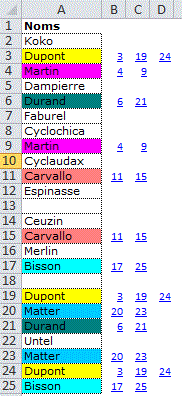
Sub GroupHyperLien()
Application.ScreenUpdating = False
Set Rng = Range("A2", [A65000].End(xlUp))
Rng.Offset(, 1).Resize(, 5).Clear
Rng.Interior.ColorIndex = xlNone
couleurs = Array(3, 4, 6, 7, 8, 14, 15, 17, 20, 22, 24, 26,
27, 28, 33, 34, 35, 36, 37, 38, 39, 40, 42, 43, 44, 45, 46, 50,
53)
Set d = CreateObject("Scripting.Dictionary")
Set d2 = CreateObject("Scripting.Dictionary")
For Each c In Rng
If c <> "" Then
d.Item(c.Value) = d.Item(c.Value)
+ 1
d2.Item(c.Value) = d2.Item(c.Value)
& CStr(c.Row) & "|"
End If
Next c
nf = ActiveSheet.Name
For Each c In Rng
If c.Value <> "" Then
If d.Item(c.Value) > 1 Then
nocoul = (Application.Match(c.Value,
d.keys, 0)) Mod UBound(couleurs)
c.Interior.ColorIndex
= couleurs(nocoul)
temp = c.Value
b = Split(d2(temp), "|")
For k = 0 To UBound(b)
- 1
ActiveSheet.Hyperlinks.Add
Anchor:=Cells(c.Row, k + 2), Address:="", SubAddress:="'"
& nf & "'" & "!A" & b(k),
TextToDisplay:=b(k)
Next k
End If
End If
Next c
End Sub
Repérer les doublons entre 2 colonnes
Repérage des doublons entre 2 colonnes
Sub DoublonsRapide2col()
Set d1 = CreateObject("Scripting.Dictionary")
Set d2 = CreateObject("Scripting.Dictionary")
Set plage1 = Range("A1", [a65000].End(xlUp))
Set plage2 = Range("B1", [B65000].End(xlUp))
[A:B].Interior.ColorIndex = xlNone
For Each c In plage1
If c <> "" Then d1(c.Value) =
""
Next c
For Each c In plage2
If d1.exists(c.Value) Then c.Interior.ColorIndex
= 3
If c <> "" Then d2(c.Value) =
""
Next c
For Each c In plage1
If d2.exists(c.Value) Then c.Interior.ColorIndex
= 4
Next c
End Sub
Repérage de tous les doublons (entre 2 colonnes + doublons dans chaque colonne)
Sub DoublonsRapideTous()
Set d1 = CreateObject("Scripting.Dictionary")
Set d2 = CreateObject("Scripting.Dictionary")
Set plage1 = Range("A1", [a65000].End(xlUp))
Set plage2 = Range("B1", [B65000].End(xlUp))
[A:B].Interior.ColorIndex = xlNone
For Each c In plage1
If c <> "" Then d1(c.Value)
= d1(c.Value) + 1
Next c
For Each c In plage2
If c <> "" Then d2(c.Value) = d2(c.Value)
+ 1
If d1.exists(c.Value) Then c.Interior.ColorIndex
= 3
Next c
For Each c In plage1
If d2.exists(c.Value) Then c.Interior.ColorIndex
= 4
If d1(c.Value) > 1 Then c.Interior.ColorIndex
= 4
Next c
For Each c In plage2
If d2(c.Value) > 1 Then c.Interior.ColorIndex
= 3
Next c
End Sub
Chaque groupe de doublons a une couleur différente
Doublons 2 colonnesCoulDiff
Sub DoublonsEntre2ColonnesCoulDiff()
Set d = CreateObject("Scripting.Dictionary")
couleurs = Array(3, 4, 6, 7, 8, 15, 17, 20, 22, 24, 26, 27,
28, 33, 34, 35, 36, 37, 38, 39, 40, 42, 43, 44, 45, 46, 50, 53)
Set plage1 = Range("A2:A" & [a65000].End(xlUp).Row)
Set plage2 = Range("B2:B" & [b65000].End(xlUp).Row)
Union(plage1, plage2).Interior.ColorIndex = xlNone
For Each C In plage1
d.Item(C.Value) = d.Item(C.Value) &
C.Row & "-"
Next C
For Each C In plage2
If d.exists(C.Value) Then
nocoul = (Application.Match(C.Value,
d.keys, 0)) Mod UBound(couleurs)
C.Interior.ColorIndex = couleurs(nocoul)
a = Split(d.Item(C.Value), "-")
For k = LBound(a) To UBound(a)
- 1
tmp = a(k) - plage1.Row
+ 1
plage1(tmp).Interior.ColorIndex
= couleurs(nocoul)
Next k
End If
Next C
End Sub
Doublons 2 colonneCommentaire
Indique les no des lignes qui contiennent des doublons.
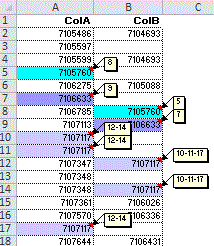
Liste des doublons en colonne A et liste des doublons en colonne B

Sub ListeDoublonsColA()
Set d1 = CreateObject("Scripting.Dictionary")
Set d2 = CreateObject("Scripting.Dictionary")
For Each c In Range([a2], [a65000].End(xlUp))
If c <> "" And d1.exists(c.Value)
Then d2(c.Value) = d1(c.Value) & c.Address & "-"
d1(c.Value) = d1(c.Value) & c.Address &
"-"
Next c
If d2.Count > 0 Then
[J2].Resize(d2.Count, 1) = Application.Transpose(d2.keys)
[K2].Resize(d2.Count, 1) = Application.Transpose(d2.Items)
End If
End Sub
Liste des doublons entre 2 colonnes
Sub DoublonsEntre2ColonnesRapport2()
Set d1 = CreateObject("Scripting.Dictionary")
Set plage1 = Range("a2:a" & [a65000].End(xlUp).Row)
Set plage2 = Range("b2:b" & [b65000].End(xlUp).Row)
For Each c In plage2
d1.Item(c.Value) = d1.Item(c.Value) &
c.Address & "-"
Next c
I = 2
For Each c In plage1
If d1.exists(c.Value) Then
Cells(I, "P") = c
Cells(I, "Q") = c.Address
Cells(I, "R") = d1.Item(c.Value)
I = I + 1
End If
Next c
End Sub
Doublons dans un champ
Doublons en ligne

Sub ColoriageDoublonsNbSi()
[A1].CurrentRegion.Interior.ColorIndex = xlNone
Application.ScreenUpdating = False
For i = 1 To [A65000].End(xlUp).Row
Set champ = Cells(i, 1).Resize(, 4)
For c = 1 To 4
If Application.CountIf(champ, Cells(i,
c)) > 1 Then Cells(i, c).Interior.ColorIndex = 6
Next c
Next i
End Sub
Doublons sur plusieurs noms par cellule
Plusieurs noms par cellule.
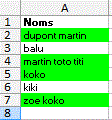
MFC: =doublons(A2;$A$2:$A$7)
Function doublons(nom As Range, noms As Range)
Application.Volatile
a = Split(nom, " ")
For Each k In a
If Application.CountIf(noms, "*" & Trim(k)
& "*") > 1 Then doublons = True
Next k
End Function
Fusion de lignes doublons
On regroupe toutes les informations des doublons Nom+prénom dans une seule ligne.
Fusion
lignes doublons
Fusion lignes
doublons 2
Regroupe lignes doublons
SousTotal
Regroupe lignes doublons
sous Total Tableau 2D
Regroupe lignes doublons
sous Total Tableau 2D 2
Sous Total 2col
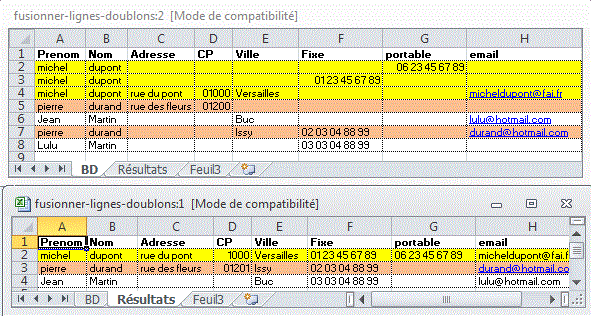
Sub RegroupeLigneS()
Set d1 = CreateObject("Scripting.Dictionary")
Set f1 = Sheets("BD")
Set f2 = Sheets("résultats")
ncol = f1.[a1].CurrentRegion.Columns.Count
nlig = f1.[a1].CurrentRegion.Rows.Count
d1.CompareMode = vbTextCompare
For ligne = 1 To nlig
crit = f1.Cells(ligne, 1) & f1.Cells(ligne,
2) ' nom+prenom
d1(crit) = ""
ligT = Application.Match(crit, d1.keys, 0)
For col = 1 To ncol
If f1.Cells(ligne, col) <> ""
Then f2.Cells(ligT, col) = f1.Cells(ligne, col).Text
Next col
If f1.Cells(ligne, ncol) <> ""
Then f1.Cells(ligne, ncol).Copy f2.Cells(ligT, ncol)
Next ligne
End Sub
Sur cette version, nous fusionnons tous les numéros de tph de chaque personne dans une cellule.
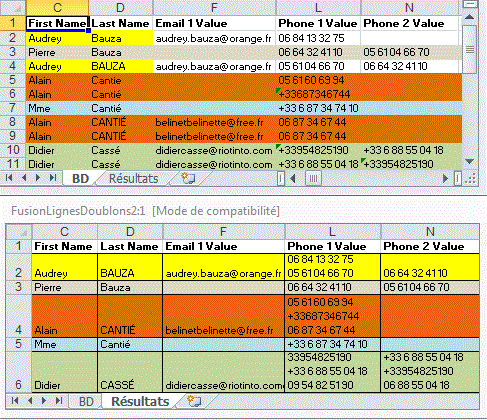
Suppression de doublons dans une BD
Suppression classique
Cette méhode devient lente si le nombre de lignes à supprimer est important.
Sub supDoublonsTradi()
Application.ScreenUpdating = False
Application.Calculation = xlCalculationManual
[A1].Sort Key1:=Range("A2"), Order1:=xlAscending,
Header:=xlGuess
For i = [A65000].End(xlUp).Row To 2 Step -1
If Cells(i, 1) = Cells(i - 1, 1) Then Rows(i).Delete
Next i
Application.Calculation = xlCalculationAutomatic
End Sub
Pour conserver le dernier:
Sub supDoublonsTradiGardeDernier()
Application.ScreenUpdating = False
Application.Calculation = xlCalculationManual
[A1].Sort Key1:=Range("A2"), Order1:=xlAscending,
Header:=xlGuess
i = 2
Do While Cells(i, 1) <> ""
If Cells(i, 1) = Cells(i + 1, 1) Then Rows(i).Delete
Else i = i + 1
Loop
Application.Calculation = xlCalculationAutomatic
End Sub
Suppression de doublons avec Totalisation des montants
Les montants sont totalisés.

Sub supDoublonsTotal()
[A2].CurrentRegion.Sort , key1:=[A2], Header:=xlYes
ligne = 2
Do While Cells(ligne, 1) <> ""
If Cells(ligne, 1) = Cells(ligne + 1, 1) Then
Cells(ligne, "c")
= Cells(ligne, "c") + Cells(ligne + 1, "c")
Rows(ligne + 1).Delete
Else
ligne = ligne + 1
End If
Loop
End Sub
Regroupe les prénoms des enfants
Les prénoms des enfants sont regroupés sur la même ligne.
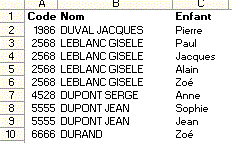
Sub supDoublonsRegroupe()
ligne = 2: col = 4
Do While Cells(ligne, 1) <> ""
If Cells(ligne, 1) = Cells(ligne + 1, 1) Then
Cells(ligne, col) = Cells(ligne
+ 1, 3)
col = col + 1
Rows(ligne + 1).Delete
Else
ligne = ligne + 1
col = 4
End If
Loop
End Sub
Suppression de doublons rapide dans une BD avec Dictionary
0,23 sec pour 10.000 éléments
Le test de doublon se fait seulement sur la colonne A
SupDoublons
Dictionary
SupDoublons
Dictionary Totalisation
SupDoublonsGardeLesNonDoublons
Sub SupDoublonsColA()
Application.ScreenUpdating = False
Set f1 = Sheets("BD")
a = f1.Range("A1").CurrentRegion.Value
Dim c()
ReDim c(1 To UBound(a, 1), 1 To UBound(a, 2))
ligne = 1
Set mondico = CreateObject("Scripting.Dictionary")
For i = 1 To UBound(a)
If Not mondico.exists(a(i, 1)) Then
mondico.Add a(i, 1), 1
For k = 1 To UBound(a, 2): c(ligne,
k) = a(i, k): Next k
ligne = ligne + 1
End If
Next
Sheets("resultat").[A1].Resize(mondico.Count, UBound(a,
2)) = c
End Sub
La version ci dessous conserve la présentation.
SupDoublonsDictionary Présentation
Sub SupDoublonsColA()
Application.ScreenUpdating = False
Set f1 = Sheets("BD")
a = f1.Range("A2:A" & f1.[A65000].End(xlUp).Row)
Set mondico = CreateObject("Scripting.Dictionary")
For i = 1 To UBound(a)
If Not mondico.exists(a(i, 1)) Then
mondico.Add a(i, 1), ""
a(i, 1) = 0
Else
a(i, 1) = "sup"
End If
Next
f1.Columns("b:b").Insert Shift:=xlToRight
f1.[B2].Resize(UBound(a)) = a
f1.[A2].CurrentRegion.Sort Key1:=f1.Range("B2"),
Order1:=xlAscending, Header:=xlGuess
On Error Resume Next
f1.Range("B2:B65000").SpecialCells(xlCellTypeConstants,
2).EntireRow.Delete
f1.Columns("b:b").Delete Shift:=xlToLeft
End Sub
On considère que les lignes pour lesquelles toutes les colonnes sont identiques sont des doublons.
Sub SupDoublonsToutesCol()
Application.ScreenUpdating = False
Set f1 = Sheets("BD")
a = f1.Range("A1").CurrentRegion.Value
Dim c()
ReDim c(1 To UBound(a, 1), 1 To UBound(a, 2))
ligne = 1
Set mondico = CreateObject("Scripting.Dictionary")
For i = 1 To UBound(a)
temp = ""
For k = 1 To UBound(a, 2): temp = temp & a(i,
k): Next
If Not mondico.exists(temp) Then
mondico.Add temp, 1
For k = 1 To UBound(a, 2): c(ligne,
k) = a(i, k): Next k
ligne = ligne + 1
End If
Next
Sheets("resultat").[A1].Resize(mondico.Count, UBound(a,
2)) = c
End Sub
Suppression de doublons sans modifier l'ordre
Sur colonne A
Sub supdoublons()
Application.ScreenUpdating = False
Application.Calculation = xlCalculationManual
Set champ = Range("A1:A" & [A65000].End(xlUp).Row)
For i = [A65000].End(xlUp).Row To 1 Step -1
If Application.CountIf(champ, Cells(i, 1)) >
1 Then
Cells(i, 1).Delete Shift:=xlUp
' ou Rows(i).Delete
End If
Next i
Application.Calculation = xlAutomatic
End Sub
Doublons sur colonne A et C avec Dictionary
Le test de doublon se fait sur la concaténation
des colonnes A et C.
Rapide si taux de suppression faible. 2 s pour 10.0000 lignes et taux
suppression 5%
Sub OrdreRespectéDictionary()
Set MonDico = CreateObject("Scripting.Dictionary")
Application.ScreenUpdating = False
i = 2
Do While Cells(i, "A") <> ""
If Not MonDico.Exists(Cells(i, "A") &
Cells(i, "C")) Then
MonDico(Cells(i, "A") &
Cells(i, "C")) = ""
i = i + 1
Else
Rows(i).EntireRow.Delete
End If
Loop
Autre exemple
L'ordre est conservé. On garde le premier
ou le dernier.
Le test de doublon se fait sur la colonne C.
Sub GardeDernier()
Set MonDico = CreateObject("Scripting.Dictionary")
Application.ScreenUpdating = False
i = [A65000].End(xlUp).Row
Do While i > 2
temp = Cells(i, "C")
If Not MonDico.Exists(temp) Then
MonDico(temp) = ""
i = i - 1
Else
Rows(i).EntireRow.Delete
i = i - 1
End If
Loop
End Sub
Sub GardePremier()
Set MonDico = CreateObject("Scripting.Dictionary")
Application.ScreenUpdating = False
i = 2
Do While i < [A65000].End(xlUp).Row
temp = Cells(i, "C")
If Not MonDico.Exists(temp) Then
MonDico(temp) = ""
i = i + 1
Else
Rows(i).EntireRow.Delete
End If
Loop
End Sub
Sub supX()
[B2:B65000].SpecialCells(xlCellTypeConstants, 2).EntireRow.Delete
End Sub
Sur colonne A et C avec le filtre élaboré
Les doublons sont testés sur la concaténation des colonnes A et C.
Sub sup_Doublons()
[A1].Sort Key1:=[A2], Order1:=xlAscending, Key2:=[C2] _
, Order2:=xlAscending, Header:=xlGuess
[G:G].Insert Shift:=xlToRight
[G2].Formula = "=AND(A1=A2,c1=c2)"
[A1:E1000].AdvancedFilter Action:=xlFilterInPlace, CriteriaRange:=[G1:G2]
If MsgBox("Etes vous sûr?", vbYesNo)
= vbYes Then
Range("_FilterDataBase").Offset(1,
0).Resize(Range("_FilterDataBase"). _
Rows.Count - 1).SpecialCells(xlCellTypeVisible).Delete
Shift:=xlUp
Else
MsgBox "Annulé"
End If
ActiveSheet.ShowAllData
[G:G].Delete Shift:=xlToLeft
End Sub
Une autre façon consiste à extraire une liste sans doublons sur une autre feuille
Sub sup_Doublons2()
[A1].Sort Key1:=[A2], Order1:=xlAscending, Key2:=[C2],Order2:=xlAscending,
Header:=xlGuess
[G:G].Insert Shift:=xlToRight
[G2].Formula = "=OR(A1<>A2,c1<>c2)"
Sheets(2).Cells.ClearContents
[A1:C1000].AdvancedFilter Action:=xlFilterCopy, CriteriaRange:=[G1:G2],
CopyToRange:=Sheets(2).[A1]
[G:G].Delete Shift:=xlToLeft
End Sub
Extraction sans doublon:on veut garder le dernier
Filtre le dernier de chaque groupe (colonne D): 100,101,102,..
On masque les autres lignes.
Dans le critère en I2:=ESTERREUR(1/(D2=D3))
Sub FiltreElab()
[A1:F10000].AdvancedFilter Action:=xlFilterInPlace, CriteriaRange:=[I1:I2]
End Sub
-Logiquement, la formule du critère devrait être
=D2<>D3
-Pour la dernière ligne (ligne11), l'interpréteur
Excel va évaluer =D11<>D12 mais pour lui
D12 n'appartient pas
au UsedRange. Cette ligne n'est donc pas prise en compte.
-Pour que la ligne D12 soit prise en compte, il faudrait q'une cellule
quelconque après la ligne 11 soit documentée
-Avec 1/(D2=D3), on obtient une division
par 0 à chaque fois que Dn<>Dn+1. Cette
division par 0 est détectée par =EstErreur(1/(Dn=Dn+1).
-Pour la dernière ligne (ligne11), l'interpréteur Excel
va évaluer =1/(D11=D12). D12 n'appartenant pas
au UsedRange, il y a une erreur. Celle ci est également
détectée par EstErreur()
Autre méthode sans le filtre élaboré
Sub Filtre()
Set f = Sheets("BD")
Set Mondico = CreateObject("Scripting.Dictionary")
For i = f.[A65000].End(xlUp).Row To 2 Step -1
If Not Mondico.Exists(f.Cells(i, "d").Value)
Then Mondico(f.Cells(i, "d").Value) = "" Else f.Rows(i).Hidden
= True
Next i
End Sub
Extraction sans doublon:on veut garder le premier
Dans l'exemple, la BD est triée par An,format,vins,prix.
il y a deux fois la référence 2003 Armailhac 750Ml. On veut
garder uniquement le premier fournisseur
(le moins cher).
Le critère en G2:=ESTERR(OU(1/(A1=A2);1/(B1=B2);1/(C1=C2)))
Suppression de doublons: on veut garder le km maximum
Les doublons sont testés sur la colonne A. On conserve la ligne avec le kilométrage maximum.
Sub test4()
Application.ScreenUpdating = False
a = Range("A3:C" & [C65000].End(xlUp).Row)
Set dico = CreateObject("Scripting.Dictionary")
Set dicoDate = CreateObject("Scripting.Dictionary")
For i = LBound(a) To UBound(a)
If a(i, 3) > dico(a(i, 1)) Then dico(a(i, 1))
= a(i, 3): dicoDate(a(i, 1)) = a(i, 2)
Next i
[E3].Resize(dico.Count) = Application.Transpose(dico.keys)
[F3].Resize(dico.Count) = Application.Transpose(dicoDate.items)
[G3].Resize(dico.Count) = Application.Transpose(dico.items)
End Sub
Autre méthode s'il y a plus de colonnes
Sub test3()
Application.ScreenUpdating = False
a = Range("A3:C" & [C65000].End(xlUp).Row)
Set dico = CreateObject("Scripting.Dictionary")
colKm = 3
For i = LBound(a) To UBound(a)
clé = a(i, 1)
If dico.exists(clé) Then
If a(i, colKm) > a(dico(clé),
colKm) Then dico(clé) = i
Else
dico(clé) = i
End If
Next i
ligne = 3
For Each clé In dico.keys
For k = 1 To UBound(a, 2): Cells(ligne, k + 4)
= a(dico(clé), k): Next k
ligne = ligne + 1
Next
End Sub
Suppression lignes identiques
Supprime les lignes identiques (colonnes A,C,E) (2 sec pour 65.000 lignes)
Sub SupLignesIdentiques()
Application.ScreenUpdating = False
Set f1 = Sheets("BD")
a = f1.Range("A1").CurrentRegion.Value
Set mondico = CreateObject("Scripting.Dictionary")
Set mondico2 = CreateObject("Scripting.Dictionary")
For i = 1 To UBound(a)
temp = a(i, 1) & a(i, 3) & a(i, 5)
mondico(temp) = mondico(temp) + 1
Next
For i = 1 To UBound(a)
temp = a(i, 1) & a(i, 3) & a(i, 5)
If mondico.Item(temp) = 1 Then mondico2(temp)
= i
Next
Dim c()
ReDim c(1 To mondico.Count, 1 To UBound(a, 2))
ligne = 1
For Each i In mondico2.items
For k = 1 To UBound(a, 2): c(ligne, k) =
a(i, k): Next k
ligne = ligne + 1
Next i
Sheets("résultat").[A1].Resize(mondico.Count,
UBound(a, 2)) = c
Sheets("résultat").Select
End Sub
Suppression doublons en colonne
Obtenir la liste des doublons et des uniques avec le filtre élaboré
Pour obtenir la liste des immatriculations en doublon
Le critère en M2 contient la formule: =NB.SI(BD!$A$2:$A$1000;BD!A2)>1
Sub Doublons()
Sheets("BD").[A1:K1000].AdvancedFilter Action:=xlFilterCopy,
_
CriteriaRange:=[M1:M2], CopyToRange:=[A1:K1],
Unique:=True
End Sub
Pour obtenir la liste des immatriculations uniques
Le critère en M2 contient la formule: =NB.SI(BD!$A$2:$A$1000;BD!A2)=1
Sub Uniques()
Sheets("BD").[A1:K1000].AdvancedFilter Action:=xlFilterCopy,
_
CriteriaRange:=[M1:M2], CopyToRange:=[A1:K1],
Unique:=False
End Sub
Suppression rapide des doublons de 2 listes
0,1 sec pour 10.000 lignes.
Sub sup()
a = Range("A2:A" & [A65000].End(xlUp).Row)
Set MonDico1 = CreateObject("Scripting.Dictionary")
For Each c In a
If Not MonDico1.exists(c) Then MonDico1.Add c,
c
Next c
b = Range("b2:b" & [b65000].End(xlUp).Row)
Set MonDico2 = CreateObject("Scripting.Dictionary")
For Each c In b
If Not MonDico1.exists(c) Then If Not MonDico2.exists(c)
Then MonDico2.Add c, c
Next c
[B2:B1000].ClearContents
[b2].Resize(MonDico2.Count, 1) = Application.Transpose(MonDico2.items)
End Sub
Fonction SansDoublons
Fonction
Sans Doublons
FonctionUnique
FiltreDynamique
Function SansDoublons(champ As Range)
Set mondico = CreateObject("Scripting.Dictionary")
For Each c In champ
If Not mondico.Exists(c.Value) And c.Value <>
"" Then mondico.Add c.Value, c.Value
Next c
SansDoublons = Application.Transpose(mondico.items)
End Function
Function SansDoublons2(champ As Range)
Set mondico = CreateObject("Scripting.Dictionary")
For Each c In champ
If Not mondico.Exists(c.Value) And c.Value
<> "" Then mondico.Add c.Value, c.Value
Next c
Dim temp()
ReDim temp(1 To champ.Count)
i = 1
For Each c In mondico.items
temp(i) = c
i = i + 1
Next
SansDoublons2 = Application.Transpose(temp)
End Function
Fonction SansDoublonsTrié
Pour 10.000 éléments, on obtient un temps de 0,15 sec (en matriciel pour 200 éléments, le temps est > 2sec)
Function SansDoublonsTrié(champ As Range)
Set mondico = CreateObject("Scripting.Dictionary")
temp = champ
For Each c In temp
If c <> "" Then mondico(c) = ""
Next c
Dim b()
ReDim b(1 To Application.Caller.Rows.Count)
i = 1
For Each c In mondico.keys
b(i) = c
i = i + 1
Next
Call tri(b, 1, mondico.Count)
SansDoublonsTrié = Application.Transpose(b)
End Function
Sub tri(a, gauc, droi) ' Quick sort
ref = a((gauc + droi) \ 2)
g = gauc: d = droi
Do
Do While a(g) < ref: g = g + 1: Loop
Do While ref < a(d): d = d - 1: Loop
If g <= d Then
temp = a(g): a(g) = a(d): a(d)
= temp
g = g + 1: d = d - 1
End If
Loop While g <= d
If g < droi Then Call tri(a, g, droi)
If gauc < d Then Call tri(a, gauc, d)
End Sub
Utilisation d'une fonction personalisée à partir de VBA
Sub Essai()
[B2].Resize(UBound(SansDoublons([A2:A13]))) = SansDoublons([A2:A13])
[F2].Resize(UBound(SansDoublons([E2:E13]))) = SansDoublons([E2:E13])
End Sub
Function SansDoublons(champ As Range)
Set mondico = CreateObject("Scripting.Dictionary")
For Each c In champ
If c.Value <> "" Then mondico(c.Value)
= c.Value
Next c
Dim temp()
SansDoublons = Application.Transpose(mondico.items)
End Function
Eléments communs à 2 listes
Colorie les communs à 2 listes
ColorieCommuns
ColorieCommunsCoulDiff
Sub ColorieCommuns()
Set f = Sheets("feuil1")
Set a = f.Range("A2:A" & [A65000].End(xlUp).Row)
Set b = f.Range("C2:C" & [C65000].End(xlUp).Row)
b.Interior.ColorIndex = xlNone
a.Interior.ColorIndex = xlNone
Set MonDico1 = CreateObject("Scripting.Dictionary")
Set MonDico2 = CreateObject("Scripting.Dictionary")
For Each c In a
MonDico1(c.Value) = c.Value
Next c
For Each c In b
MonDico2(c.Value) = c.Value
If MonDico1.exists(c.Value) Then c.Interior.ColorIndex
= 3
Next c
For Each c In a
If MonDico2.exists(c.Value) Then c.Interior.ColorIndex
= 3
Next c
End Sub
Comparaison des montants de 2 Bases de données
Pour 2 codes identiques dans les 2 BD, nous comparons si les montants sont différents.
Compare
montant 2 BD
Compare codes 2 BD
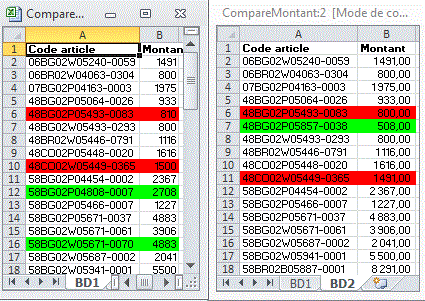
Sub CompareMontant()
Set f1 = Sheets("BD1")
Set f2 = Sheets("BD2")
f1.Range("A1:B10000").Sort Key1:=f1.[a2], Order1:=xlAscending,
Header:=xlYes
f2.Range("A1:B10000").Sort Key1:=f2.[a2], Order1:=xlAscending,
Header:=xlYes
Set a = f1.Range("A2:A" & f1.[a65000].End(xlUp).Row)
Set b = f2.Range("a2:a" & f2.[a65000].End(xlUp).Row)
b.Resize(, 2).Interior.ColorIndex = xlNone
a.Resize(, 2).Interior.ColorIndex = xlNone
Set d1 = CreateObject("Scripting.Dictionary")
Set d2 = CreateObject("Scripting.Dictionary")
For Each c In a
d1(c.Value) = c.Offset(, 1).Value
Next c
For Each c In b
d2(c.Value) = c.Offset(, 1).Value
If d1.exists(c.Value) Then
If d1.Item(c.Value) <>
d2.Item(c.Value) Then c.Resize(, 2).Interior.ColorIndex = 3
Else
c.Resize(, 2).Interior.ColorIndex
= 4
End If
Next c
For Each c In a
If d2.exists(c.Value) Then
If d1.Item(c.Value) <> d2.Item(c.Value)
Then c.Resize(, 2).Interior.ColorIndex = 3
Else
c.Resize(, 2).Interior.ColorIndex
= 4
End If
Next c
End Sub
Comparaison avec MFC
On compare 2 listes de prix dans les colonnes A:B de de 2 feuilles BD1 et BD2
Noms de champ
Base1 ='BD1'!$A$2:$B$60
Base2 ='BD2'!$A$2:$B$58
Le produit existe t-il?: =ESTERREUR(RECHERCHEV($A2;Base2;1;FAUX))
ou =ESTERREUR(EQUIV($A2;INDEX(Base2;;1);0))
Le prix est-il différent?: =RECHERCHEV($A2;Base2;2;FAUX)<>$B2
Liste des communs à 2 listes - différence entre 2 listes
0,25 seconde pour 2 listes de 10.000 éléments.
Eléments
Communs
Compare 2 Champs
Sub Communs()
a = Range("A2:A" & [A65000].End(xlUp).Row)
Set MonDico1 = CreateObject("Scripting.Dictionary")
For Each c In a
If Not MonDico1.exists(c) Then MonDico1.Add c,
c
Next c
b = Range("C2:C" & [C65000].End(xlUp).Row)
Set MonDico2 = CreateObject("Scripting.Dictionary")
For Each c In b
If MonDico1.exists(c) Then If Not MonDico2.exists(c)
Then MonDico2.Add c, c
Next c
[G2].Resize(MonDico2.Count, 1) = Application.Transpose(MonDico2.items)
End Sub
Sub Fusion()
Set MonDico = CreateObject("Scripting.Dictionary")
a = Range("A2:A" & [A65000].End(xlUp).Row)
b = Range("C2:C" & [C65000].End(xlUp).Row)
For Each c In a
If Not MonDico.exists(c) Then MonDico.Add c, c
Next c
For Each c In b
If Not MonDico.exists(c) Then MonDico.Add c, c
Next c
[E2].Resize(MonDico.Count, 1) = Application.Transpose(MonDico.items)
End Sub
Sub Liste2_Liste1()
a = Range("A2:A" & [A65000].End(xlUp).Row)
Set MonDico1 = CreateObject("Scripting.Dictionary")
For Each c In a
If Not MonDico1.exists(c) Then MonDico1.Add c,
c
Next c
b = Range("C2:C" & [C65000].End(xlUp).Row)
Set MonDico2 = CreateObject("Scripting.Dictionary")
For Each c In b
If Not MonDico1.exists(c) Then If Not MonDico2.exists(c)
Then MonDico2.Add c, c
Next c
[I2].Resize(MonDico2.Count, 1) = Application.Transpose(MonDico2.items)
End Sub
Sub Liste1_Liste2()
a = Range("C2:C" & [C65000].End(xlUp).Row)
Set MonDico1 = CreateObject("Scripting.Dictionary")
For Each c In a
If Not MonDico1.exists(c) Then MonDico1.Add c, c
Next c
b = Range("A2:A" & [A65000].End(xlUp).Row)
Set MonDico2 = CreateObject("Scripting.Dictionary")
For Each c In b
If Not MonDico1.exists(c) Then If Not MonDico2.exists(c) Then MonDico2.Add
c, c
Next c
[K2].Resize(MonDico2.Count, 1) = Application.Transpose(MonDico2.items)
End Sub
Eléments communs à 2 listes avec 2 colonnes
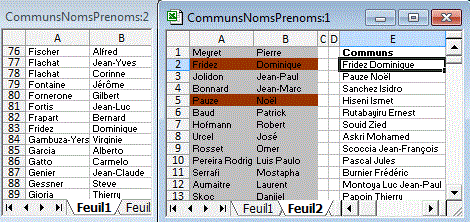
Sub Communs()
Set f1 = Sheets("feuil1")
Set f2 = Sheets("feuil2")
Set MonDico1 = CreateObject("Scripting.Dictionary")
For Each c In f1.Range("A2:A" & f1.[A65000].End(xlUp).Row)
MonDico1(c & " " & c.Offset(,
1)) = ""
Next c
Set MonDico2 = CreateObject("Scripting.Dictionary")
For Each c In f2.Range("A2:A" & f2.[A65000].End(xlUp).Row)
tmp = c & " " & c.Offset(, 1)
If MonDico1.exists(tmp) Then If Not MonDico2.exists(tmp)
Then MonDico2(tmp) = ""
Next c
f2.[E2].Resize(MonDico2.Count, 1) = Application.Transpose(MonDico2.keys)
End Sub
Sur cette version, on récupère les informations des 2 feuilles
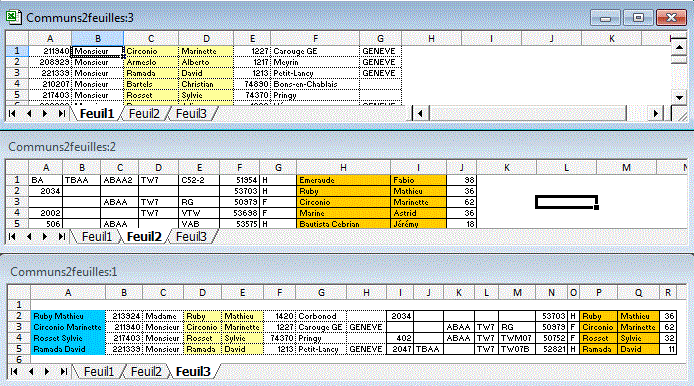
Sub Communs()
Set f1 = Sheets("feuil1")
Set f2 = Sheets("feuil2")
Set f3 = Sheets("feuil3")
Set mondico1 = CreateObject("Scripting.Dictionary")
For Each c In f1.Range("c1:c" & f1.[c65000].End(xlUp).Row)
' adapter
mondico1(c & " " & c.Offset(,
1)) = c.Row
Next c
Set mondico2 = CreateObject("Scripting.Dictionary")
For Each c In f2.Range("h1:h" & f2.[h65000].End(xlUp).Row)
' adapter
tmp = c & " " & c.Offset(, 1)
If mondico1.exists(tmp) Then If Not mondico2.exists(tmp)
Then mondico2(tmp) = c.Row
Next c
f3.[A2].Resize(mondico2.Count, 1) = Application.Transpose(mondico2.keys)
col1 = f1.[A1].CurrentRegion.Columns.Count ' adapter
col2 = f2.[A1].CurrentRegion.Columns.Count ' adapter
lig = 2
For Each c In mondico2
f1.Cells(mondico1(c), 1).Resize(, col1).Copy f3.Cells(lig,
2)
f2.Cells(mondico2(c), 1).Resize(, col2).Copy f3.Cells(lig,
col1 + 2)
lig = lig + 1
Next c
End Sub
Si les données sur feui1 ou feuil2 comportent des colonnes vides.
col1 = f1.Cells.Find("*", , , , xlByColumns, xlPrevious).Column
col2 = f2.Cells.Find("*", , , , xlByColumns, xlPrevious).Column
Communs avec filtre élaboré
En E2:=NB.SI($B$2:$B$10000;A2)>0
Sub communs()
[A1:A10000].AdvancedFilter Action:=xlFilterCopy, CriteriaRange:=[E1:E2],
CopyToRange:=[G1]
End Sub
Fonction liste différence triée entre 2 listes
Function DiffTriée(a As Range, b As Range)
Application.Volatile
Dim temp()
ReDim temp(1 To Application.Max(a.Count, b.Count))
Set mondico = CreateObject("Scripting.Dictionary")
For Each c In b: mondico.Item(c) = c: Next c
k = 0
For Each c In a
If c <> "" And Not mondico.exists(c)
Then
k = k + 1
temp(k) = c
End If
Next c
Call tri(temp, 1, k)
DiffTriée = Application.Transpose(temp)
End Function
Sub tri(a(), gauc, droi) ' Quick sort
ref = a((gauc + droi) \ 2)
g = gauc: d = droi
Do
Do While a(g) < ref: g = g + 1: Loop
Do While ref < a(d): d = d - 1: Loop
If g <= d Then
temp = a(g): a(g) = a(d): a(d) = temp
g = g + 1: d = d - 1
End If
Loop While g <= d
If g < droi Then Call tri(a, g, droi)
If gauc < d Then Call tri(a, gauc, d)
End Sub
Autre version
Function DiffTriée2(a As Range, b As Range)
Dim temp()
ReDim temp(1 To a.Count)
k = 0
For i = 1 To a.Count
If IsError(Application.Match(a(i), b, 0)) And
a(i) <> "" And a(i) <> 0 Then
k = k + 1
temp(k) = a(i)
End If
Next i
Call tri(temp, 1, k)
DiffTriée2 = Application.Transpose(temp)
End Function
Communs aux 2 listes
Function CommunsTriée(a As Range, b As Range)
Application.Volatile
Dim temp()
ReDim temp(1 To Application.Max(a.Count, b.Count))
Set mondico = CreateObject("Scripting.Dictionary")
For Each c In b: mondico.Item(c.Value) = c.Value: Next c
k = 0
For Each c In a
If c.Value <> "" And
mondico.exists(c.Value) Then
k = k + 1
temp(k) = c.Value
End If
Next c
Call tri(temp, 1, k)
CommunsTriée = Application.Transpose(temp)
End Function
Différence entre 2 BD
Cette méthode classique est peu rapide si les BD ont des tailles importantes.
Sub DiffBD1BD2()
ligneEcrit = 2
nblignes = Sheets("BD1").[A65000].End(xlUp).Row
+ 1
For i = 2 To nblignes
x = Sheets("BD1").Cells(i, 1)
If IsError(Application.Match(x, Sheets("BD2").[A2:A1000],
0)) Then
Cells(ligneEcrit, 1) = x
ligneEcrit = ligneEcrit + 1
End If
Next i
'---
ligneEcrit = 2
nblignes = Sheets("BD2").[A65000].End(xlUp).Row
+ 1
For i = 2 To nblignes
x = Sheets("BD2").Cells(i, 1)
If IsError(Application.Match(x, Sheets("BD1").[A2:A1000],
0)) Then
Cells(ligneEcrit, 2) = x
ligneEcrit = ligneEcrit + 1
End If
Next i
End Sub
Méthode rapide
On veut la liste des clés de Base2 qui n'existent pas dans Base1.
Sub BD2_BD1()
Set f1 = Sheets("Base1")
Set f2 = Sheets("Base2")
Set MonDico1 = CreateObject("Scripting.Dictionary")
For Each c In f1.Range("a2:a" & f1.[a65000].End(xlUp).Row)
MonDico1.Item(c.Value) = c.Value
Next c
Set MonDico2 = CreateObject("Scripting.Dictionary")
For Each c In f2.Range("a2:a" & f2.[b65000].End(xlUp).Row)
If Not MonDico1.exists(c.Value) Then
If Not MonDico2.exists(c.Value) Then
MonDico2.Add c.Value, c.Row
End If
Next c
Sheets("Base2_Base1").[A2].Resize(MonDico2.Count,
1) = Application.Transpose(MonDico2.keys)
Sheets("Base2_Base1").[b2].Resize(MonDico2.Count,
1) = Application.Transpose(MonDico2.items)
End Sub
Lignes qui existent dans BD1 et pas dans BD2
On recherche les lignes de BD1 qui n'existent
pas dans BD2.
-La clé de comparaison est le nom.
-Certains noms ont des caractères accentués dans BD1 et
pas dans BD2 (BDELHADI Lilià/BDELHADI Lilia).
Le fichier contient également la liste des Communs avec les infos des 2 BD
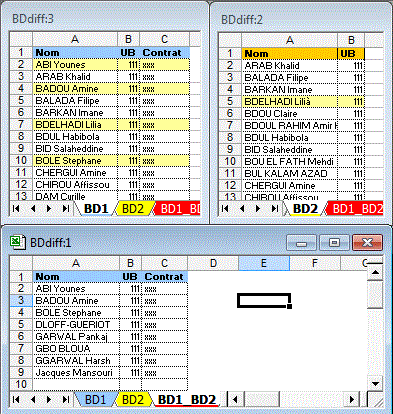
Sub BD1_nonBD2()
Application.ScreenUpdating = False
Set f1 = Sheets("BD1")
Set f2 = Sheets("BD2")
a = f1.Range("A1").CurrentRegion.Value
b = f2.Range("A1").CurrentRegion.Value
Set mondico = CreateObject("Scripting.Dictionary")
For i = 2 To UBound(b): mondico(UCase(sansAccent(b(i,
1)))) = "": Next i
ligne = 1
Dim c
ReDim c(1 To Application.Max(UBound(a), UBound(b)),
1 To UBound(a, 2))
For i = 2 To UBound(a)
If Not mondico.Exists(UCase(sansAccent(a(i,
1)))) Then
For K = 1 To UBound(a,
2): c(ligne, K) = a(i, K): Next K
ligne = ligne +
1
End If
Next i
Sheets("BD1_BD2").[A2:C1000].ClearContents
Sheets("BD1_BD2").[A2].Resize(UBound(a,
1), UBound(a, 2)) = c
End Sub
Function sansAccent(chaine)
codeA = "ÉÈÊËÔéèêëàçùôûïî"
codeB = "EEEEOeeeeacuouii"
temp = chaine
For i = 1 To Len(temp)
p = InStr(codeA, Mid(temp, i, 1))
If p > 0 Then Mid(temp, i, 1) = Mid(codeB,
p, 1)
Next
sansAccent = temp
End Function
Comparaison de 2 listes avec quantités
Sub CompareBD1()
Application.ScreenUpdating = False
Set f1 = Sheets("Liste A")
Set f2 = Sheets("Liste B")
f2.[b:b].ClearComments
f1.[b:b].ClearComments
Set mondico1 = CreateObject("Scripting.Dictionary")
For Each c In f1.Range("A2:A" & f1.[A65000].End(xlUp).Row)
mondico1(c.Value) = c.Offset(, 1).Value
Next c
Set mondico2 = CreateObject("Scripting.Dictionary")
'-- Liste B
For Each c In f2.Range("A2:A" & f2.[A65000].End(xlUp).Row)
mondico2(c.Value) = c.Offset(, 1).Value
If mondico1.exists(c.Value) Then
q = mondico1.Item(c.Value)
If q <> c.Offset(, 1).Value
Then
c.Offset(, 1).AddComment
c.Offset(, 1).Comment.Text
Text:=CStr("Ecart:" & c.Offset(, 1) - q)
c.Offset(, 1).Comment.Shape.TextFrame.AutoSize
= True
c.Offset(, 1).Comment.Visible
= True
c.Resize(, 2).Interior.ColorIndex
= 33
End If
Else
c.Resize(, 2).Interior.ColorIndex
= 3
End If
Next c
End Sub
Comparaison de 2 BD par MFC
La clé est le nom.
BD compare
Contenu différent:
-Sélectionner A2:D20
-Format/Mise en forme conditionnelle/La formule est
=INDEX(MaBD2;EQUIV($A2;INDEX(MaBD2;;1);0);COLONNE())<>A2
Non trouvés dans BD1:
=ET(A2<>"";ESTNA(EQUIV($A2;INDEX(MaBD2;;1);0)))
Noms de champs
MaBD1 ='BD1'!$A$2:$D$100
MaBD2 ='BD2'!$A$2:$D$100
Lignes communes à 2 BD sur nom+prénom avec filtre élaboré
Formule du critère:
=SOMMEPROD(('BD2'!A2='BD1'!A1:A2000)*('BD2'!B2='BD1'!B1:B2000))>0
Sub ExtraitCommuns()
Sheets("BD2").[A1:G2000].AdvancedFilter Action:=xlFilterCopy,
_
CriteriaRange:=[k1:k2], CopyToRange:=[A1:G1]
End Sub
Pour la différence BD2-BD1, le critère devient
=SOMMEPROD(('BD2'!A2='BD1'!A1:A2000)*('BD2'!B2='BD1'!B1:B2000))=0
Lignes communes à 2 BD sur nom+prénom avec tableaux et dictionary
Sub communs()
Application.ScreenUpdating = False
Set f1 = Sheets("BD1")
Set f2 = Sheets("BD2")
a = f1.Range("A1").CurrentRegion.Value
b = f2.Range("A1").CurrentRegion.Value
Set MonDico1 = CreateObject("Scripting.Dictionary")
For i = 2 To UBound(a)
temp = a(i, 1) & " " & a(i,
2)
MonDico1(temp) = ""
Next i
ligne = 1
Dim c
ReDim c(1 To Application.Max(UBound(a), UBound(b)), 1 To UBound(a,
2))
For i = 2 To UBound(b)
temp = b(i, 1) & " " & b(i,
2)
If MonDico1.exists(temp) Then
For k = 1 To UBound(b, 2): c(ligne,
k) = b(i, k): Next k
ligne = ligne + 1
End If
Next
Sheets("communs").[A2].Resize(UBound(a, 1),
UBound(a, 2)) = c
End Sub
Différence entre 2 BD sur nom+prénom avec tableaux et dictionary
Sub BD2_BD1()
Application.ScreenUpdating = False
Set f1 = Sheets("BD1")
Set f2 = Sheets("BD2")
a = f1.Range("A1").CurrentRegion.Value
b = f2.Range("A1").CurrentRegion.Value
Set MonDico1 = CreateObject("Scripting.Dictionary")
For i = 2 To UBound(a)
temp = a(i, 1) & " " & a(i, 2)
MonDico1(temp) = ""
Next i
ligne = 1
Dim c
ReDim c(1 To Application.Max(UBound(a), UBound(b)), 1 To UBound(a, 2))
For i = 2 To UBound(b)
temp = b(i, 1) & " " & b(i, 2)
If Not MonDico1.exists(temp) Then
For k = 1 To UBound(b, 2): c(ligne, k) = b(i, k): Next k
ligne = ligne + 1
End If
Next
Sheets("BD2_BD1").[A2].Resize(UBound(a, 1), UBound(a, 2)) =
c
End Sub
Comparaison de 2 BD: Modifications, communs inchangés, ajouts, fusion
Des colonnes peuvent être ajoutées dans les BD sans modification du programme
CompareBD1
CompareBD2
CompareBD3
CompareBD4
Codes communs modifiés
On veut la liste des enregistrements modifiés dans
l'onglet Base2 par rapport à l'onglet
Base1.
Les champs modifiés sont coloriés en jaune.
Sub CommunsCode()
Application.ScreenUpdating = False
Set f1 = Sheets("BASE 1")
Set f2 = Sheets("BASE 2")
Set f3 = Sheets("CommunsCode")
f3.[A2:O1000].ClearContents
f3.[A2:O1000].Interior.ColorIndex = xlNone
a = f1.Range("A1").CurrentRegion.Value
b = f2.Range("A1").CurrentRegion.Value
Set mondico2 = CreateObject("Scripting.Dictionary")
For I = 2 To UBound(a)
mondico2(a(I, 1)) = ""
Next I
ligne = 2
For I = 2 To UBound(b)
temp = ""
For K = 1 To UBound(b, 2): temp = temp & b(I,
K): Next K
If mondico2.Exists(b(I, 1)) Then
Set temp = f1.Columns(1).Find(b(I,
1))
For K = 1 To UBound(b, 2)
f3.Cells(ligne,
K) = b(I, K)
If b(I, K) <>
temp.Offset(, K - 1) Then f3.Cells(ligne, K).Interior.ColorIndex = 6
Next K
f3.Cells(ligne, K) = I
ligne = ligne + 1
End If
Next
End Sub
Ajouts dans Base2/Base1
Sub BD2_BD1()
Application.ScreenUpdating = False
Set f1 = Sheets("BASE 1")
Set f2 = Sheets("BASE 2")
a = f1.Range("A1").CurrentRegion.Value
b = f2.Range("A1").CurrentRegion.Value
Set mondico1 = CreateObject("Scripting.Dictionary")
For I = 2 To UBound(a)
mondico1(a(I, 1)) = ""
Next I
ligne = 1
Dim c
ReDim c(1 To Application.Max(UBound(a), UBound(b)), 1 To UBound(a,
2) + 1)
For I = 2 To UBound(b)
temp = ""
For K = 1 To UBound(b, 2): temp = temp & b(I,
K): Next K
If Not mondico1.Exists(b(I, 1)) Then
For K = 1 To UBound(b, 2): c(ligne,
K) = b(I, K): Next K
c(ligne, K) = I
ligne = ligne + 1
End If
Next
Sheets("BD2 NON BD1").[a2].Resize(UBound(a, 1),
UBound(a, 2) + 1) = c
End Sub
Communs inchangés sur toutes les colonnes
Sub CommunsInchangés()
Application.ScreenUpdating = False
Set f1 = Sheets("BASE 1")
Set f2 = Sheets("BASE 2")
a = f1.Range("A1").CurrentRegion.Value
b = f2.Range("A1").CurrentRegion.Value
Set mondico1 = CreateObject("Scripting.Dictionary")
For I = 2 To UBound(a)
temp = ""
For K = 1 To UBound(a, 2): temp = temp & a(I,
K): Next K
mondico1(temp) = 1
Next I
ligne = 1
Dim c
ReDim c(1 To Application.Max(UBound(a), UBound(b)), 1 To UBound(a,
2))
For I = 1 To UBound(b)
temp = ""
For K = 1 To UBound(b, 2): temp = temp & b(I,
K): Next K
If mondico1.Exists(temp) Then
For K = 1 To UBound(b, 2): c(ligne,
K) = b(I, K): Next K
ligne = ligne + 1
End If
Next
Sheets("CommunsInchanges").[A1].Resize(UBound(a,
1), UBound(a, 2)) = c
End Sub
Autre exemple
On veut les codes SIRET communs aux 2 BD
Sub Communs()
Set f1 = Sheets("BD1")
Set f2 = Sheets("BD2")
Set mondico1 = CreateObject("Scripting.Dictionary")
For Each c In f1.Range("e2:e" & f1.[e65000].End(xlUp).Row)
mondico1.Item(c.Value) = c.Value
Next c
Set mondico2 = CreateObject("Scripting.Dictionary")
For Each c In f2.Range("d2:d" & f2.[d65000].End(xlUp).Row)
If mondico1.Exists(c.Value) Then If Not mondico2.Exists(c.Value)
Then mondico2.Add c.Value, c.Value
Next c
Sheets("communs").[A2].Resize(mondico2.Count, 1)
= Application.Transpose(mondico2.items)
End Sub
On veut les codes SIRET et les noms des entreprises:
Sub Communs2()
Set f1 = Sheets("BD1")
Set f2 = Sheets("BD2")
Set mondico1 = CreateObject("Scripting.Dictionary")
For Each c In f1.Range("e2:e" & f1.[e65000].End(xlUp).Row)
mondico1.Item(c.Value) = c.Value
Next c
Set mondico2 = CreateObject("Scripting.Dictionary")
For Each c In f2.Range("d2:d" & f2.[d65000].End(xlUp).Row)
If mondico1.Exists(c.Value) Then If Not mondico2.Exists(c.Value)
Then mondico2.Add c.Value, c.Offset(, -3)
Next c
Sheets("communs").[A2].Resize(mondico2.Count, 1)
= Application.Transpose(mondico2.keys)
Sheets("communs").[B2].Resize(mondico2.Count, 1)
= Application.Transpose(mondico2.items)
End Sub
On veut la différence BD2-BD1:
Sub BD2_BD1()
Set f1 = Sheets("BD1")
Set f2 = Sheets("BD2")
Set MonDico1 = CreateObject("Scripting.Dictionary")
For Each c In f1.Range("e2:e" & f1.[e65000].End(xlUp).Row)
MonDico1.Item(c.Value) = c.Value
Next c
Set MonDico2 = CreateObject("Scripting.Dictionary")
For Each c In f2.Range("d2:d" & f2.[d65000].End(xlUp).Row)
If Not MonDico1.exists(c.Value) Then If Not MonDico2.exists(c.Value)
Then MonDico2.Add c.Value, c.Offset(, -3)
Next c
Sheets("BD2_BD1").[A2].Resize(MonDico2.Count, 1)
= Application.Transpose(MonDico2.keys)
Sheets("BD2_BD1").[B2].Resize(MonDico2.Count, 1)
= Application.Transpose(MonDico2.items)
End Sub
On veut la différence BD1-BD2:
Sub BD1_BD2()
Set f1 = Sheets("BD1")
Set f2 = Sheets("BD2")
Set MonDico2 = CreateObject("Scripting.Dictionary")
For Each c In f2.Range("d2:d" & f2.[d65000].End(xlUp).Row)
MonDico2.Item(c.Value) = c.Value
Next c
Set MonDico1 = CreateObject("Scripting.Dictionary")
For Each c In f1.Range("e2:e" & f1.[d65000].End(xlUp).Row)
If Not MonDico2.exists(c.Value) Then If Not MonDico1.exists(c.Value)
Then MonDico1.Add c.Value, c.Offset(, -4)
Next c
Sheets("BD1_BD2").[A2].Resize(MonDico1.Count, 1)
= Application.Transpose(MonDico1.keys)
Sheets("BD1_BD2").[B2].Resize(MonDico1.Count, 1)
= Application.Transpose(MonDico1.items)
End Sub
Autre exemple de différence entre 2 BD
Cette méthode est rapide (<0,5 s pour 10.000 lignes).
Sub BD1_BD2()
Application.ScreenUpdating = False
Set f1 = Sheets("BD1")
Set f2 = Sheets("BD2")
a = f2.Range("A1").CurrentRegion.Value
b = f1.Range("A1").CurrentRegion.Value
Set MonDico1 = CreateObject("Scripting.Dictionary")
For i = 1 To UBound(a): MonDico1(a(i, 1)) = 1: Next i
ligne = 1
Dim c
ReDim c(1 To Application.Max(UBound(a), UBound(b)),
1 To UBound(a, 2))
For i = 1 To UBound(b)
If Not MonDico1.exists(b(i, 1)) Then
For k = 1 To UBound(b,
2): c(ligne, k) = b(i, k): Next k
ligne = ligne + 1
End If
Next
Sheets("BD1-BD2").[A2].Resize(UBound(a,
1), UBound(a, 2)) = c
End Sub
Lignes communes et différentes de 2 BD (sur toutes les colonnes)
Crée une BD avec les lignes communes à 2 BD (0,56 sec pour 10.000 lignes)
Sub Communs()
Application.ScreenUpdating = False
Set f1 = Sheets("BD1")
Set f2 = Sheets("BD2")
a = f1.Range("A1").CurrentRegion.Value
b = f2.Range("A1").CurrentRegion.Value
Set MonDico1 = CreateObject("Scripting.Dictionary")
For i = 1 To UBound(a)
temp = ""
For k = 1 To UBound(a, 2): temp = temp &
a(i, k): Next k
MonDico1(temp) = 1
Next i
ligne = 1
Dim c
ReDim c(1 To Application.Max(UBound(a), UBound(b)),
1 To UBound(a, 2))
For i = 1 To UBound(b)
temp = ""
For k = 1 To UBound(b, 2): temp = temp &
b(i, k): Next k
If MonDico1.exists(temp)
Then
For k = 1
To UBound(b, 2): c(ligne, k) = b(i, k): Next k
ligne = ligne
+ 1
End If
Next
Sheets("communs").[A1].Resize(UBound(a, 1),
UBound(a, 2)) = c
End Sub
Différence BD1-BD2 sur toutes les colonnes
Sub BD1_BD2()
Application.ScreenUpdating = False
Set f1 = Sheets("BD1")
Set f2 = Sheets("BD2")
a = f2.Range("A1").CurrentRegion.Value
b = f1.Range("A1").CurrentRegion.Value
Set MonDico1 = CreateObject("Scripting.Dictionary")
For i = 1 To UBound(a)
temp = ""
For k = 1 To UBound(a, 2): temp = temp & a(i,
k): Next k
MonDico1(temp) = 1
Next i
ligne = 1
Dim c
ReDim c(1 To Application.Max(UBound(a), UBound(b)), 1 To UBound(a,
2))
For i = 1 To UBound(b)
temp = ""
For k = 1 To UBound(b, 2): temp = temp & b(i,
k): Next k
If Not MonDico1.exists(temp) Then
For k = 1 To UBound(b, 2): c(ligne,
k) = b(i, k): Next k
ligne = ligne + 1
End If
Next
Sheets("BD1_BD2").[A2].Resize(UBound(a, 1), UBound(a,
2)) = c
End Sub
Coloriage des communs
Sub ColoriageCommuns()
Application.ScreenUpdating = False
Set f1 = Sheets("BD1")
Set f2 = Sheets("BD2")
a = f1.Range("A1").CurrentRegion.Value
b = f2.Range("A1").CurrentRegion.Value
Set mondico1 = CreateObject("Scripting.Dictionary")
For i = 2 To UBound(a)
temp = ""
For k = 1 To UBound(a, 2): temp = temp & a(i,
k): Next k
mondico1(temp) = i
Next i
For i = 1 To UBound(b)
temp = ""
For k = 1 To UBound(b, 2): temp =
temp & b(i, k): Next k
If mondico1.exists(temp) Then
f1.Cells(mondico1(temp),
1).Interior.ColorIndex = 4
f2.Cells(i, 1).Interior.ColorIndex
= 4
End If
Next
End Sub
Avec ADO
On veut les lignes communes à 2 BD d'un classeur
fermé BDCommunsADO.xls.
Les BD sont nommées BDN1 et BDN2.
La requête SQL
SELECT * FROM BDN1,BDN2 WHERE bdn1.entreprise=bdn2.entreprise AND bdn1.cp=bdn2.cp AND bdn1.code=bdn2.code AND bdn1.ville=bdn2.ville
Donne les lignes communes
Sub Communs()
' Microsoft ActiveX DataObject doit être coché
' les BD sont dans un autre classeur (BDCommunsADO.xls) sont
nommées BDN1 et BDN2
' 1,5 sec pour 10.000 éléments
repertoire = ThisWorkbook.Path
Set cnn = New ADODB.Connection
cnn.Open "DRIVER={Microsoft Excel Driver (*.xls)};ReadOnly=1;DBQ="
& repertoire & "\" & "BDCommunsADO.xls"
Sql = "SELECT * FROM BDN1,BDN2 WHERE bdn1.entreprise=bdn2.entreprise
AND bdn1.cp=bdn2.cp AND bdn1.code=bdn2.code AND bdn1.ville=bdn2.ville
"
Set rs = cnn.Execute(Sql)
tbl = rs.GetRows ' tableau à 2 dimensions on ne récupère
pas la première ligne
rs.Close
cnn.Close
Set rs = Nothing
Set cnn = Nothing
[A2].Resize(UBound(tbl, 2) + 1, 4) = Application.Transpose(tbl)
End Sub
Coloriage des communs à 2 BD avec numéros de ligne
On veut colorier les communs sur toutes les colonnes.
On indique le no de ligne de l'autre feuille où le commun existe.
La méthode est rapide(0,3 s pour 10.000 lignes)
Sub ColoriageCommuns()
ncol = 6 ' nombre
de colonnes
Application.ScreenUpdating = False
Set f1 = Sheets("BD1")
Set f2 = Sheets("BD2")
f1.Range("A1").CurrentRegion.Interior.ColorIndex
= xlNone
f2.Range("A1").CurrentRegion.Interior.ColorIndex
= xlNone
f1.Columns(ncol + 1).ClearContents
f2.Columns(ncol + 1).ClearContents
a = f1.Range("A1").CurrentRegion.Value
b = f2.Range("A1").CurrentRegion.Value
Set mondico1 = CreateObject("Scripting.Dictionary")
For i = 2 To UBound(a)
temp = ""
For k = 1 To ncol: temp = temp & a(i,
k): Next k
mondico1(temp) = i
Next i
For i = 1 To UBound(b)
temp = ""
For k = 1 To ncol: temp = temp
& b(i, k): Next k
If mondico1.exists(temp)
Then
f1.Cells(mondico1(temp),
1).Resize(, 6).Interior.ColorIndex = 4
f1.Cells(mondico1(temp),
7) = i 'mondico1(temp)
f2.Cells(i,
1).Resize(, 6).Interior.ColorIndex = 4
f2.Cells(i,
7) = mondico1(temp)
End If
Next
End Sub
Comparaison sur arrondi de champ numérique
ComparaisonArrondiNumérique
ComparaisonArrondiNumérique2
Eléments communs à plusieurs feuilles
Sub communs()
Set f1 = Sheets("10")
Set mondico1 = CreateObject("Scripting.Dictionary")
For Each c In f1.Range("a2:a" & f1.[a65000].End(xlUp).Row)
mondico1.Item(c.Value) = c.Offset(, 1).Value
Next
For Each f In Array("15", "18", "12")
Set mondico2 = CreateObject("Scripting.Dictionary")
For Each c In Sheets(f).Range("a2:a"
& Sheets(f).[a65000].End(xlUp).Row)
If mondico1.Exists(c.Value) Then mondico2(c.Value)
= c.Offset(, 1).Value
Next c
Set mondico1 = mondico2
Next f
Sheets("communs").[c2].Resize(mondico2.Count,
1) = Application.Transpose(mondico2.keys)
Sheets("communs").[d2].Resize(mondico2.Count,
1) = Application.Transpose(mondico2.items)
End Sub
ou
Sub communs2()
Set f1 = Sheets("10")
Set mondico1 = CreateObject("Scripting.Dictionary")
For Each c In f1.Range("a2:a" & f1.[a65000].End(xlUp).Row)
mondico1.Item(c.Value) = c.Offset(, 1).Value
Next
For Each f In Array("15", "18", "12")
Set mondico2 = CreateObject("Scripting.Dictionary")
a = Sheets(f).Range("a2:b" & Sheets(f).[a65000].End(xlUp).Row).Value
For i = LBound(a) To UBound(a)
If mondico1.Exists(a(i, 1))
Then mondico2(a(i, 1)) = a(i, 2)
Next i
Set mondico1 = mondico2
Next f
Sheets("communs").[c2].Resize(mondico2.Count,
1) = Application.Transpose(mondico2.keys)
Sheets("communs").[d2].Resize(mondico2.Count,
1) = Application.Transpose(mondico2.items)
End Sub
Fusion de 2BD
On veut obtenir la fusion de 2BD en éliminant les doublons.
Sub synthese()
Set onglet1 = Sheets("BD1")
Set onglet2 = Sheets("BD2")
Sheets("recap").[A2:D10000].ClearContents
Range(onglet1.[A2], onglet1.[A65000].End(xlUp).Offset(0, 2)).Copy
Sheets("recap").[A2]
For Each c In Range(onglet2.[A2], onglet2.[A65000].End(xlUp))
p = Application.Match(c, [A:A], 0)
If IsError(p) Then c.Resize(, 3).Copy [A65000].End(xlUp).Offset(1,
0)
Next c
End Sub
Fusion sans doublons de BD
On fusionne plusieurs onglets en éliminant les doublons nom/prénom. FusionSansDoublons
Sub FusionSansDoublonsDictionary()
[A2:C1000].ClearContents
Application.ScreenUpdating = False
For s = 2 To Sheets.Count ' Fusion
Range(Sheets(s).[A2], Sheets(s).[A65000].End(xlUp).End(xlToRight)).Copy
[A65000].End(xlUp).Offset(1, 0)
Next s
Set MonDico = CreateObject("Scripting.Dictionary")
Application.ScreenUpdating = False
i = 2
Do While Cells(i, "A") <> ""
If Not MonDico.Exists(Cells(i, "A")
& Cells(i, "B")) Then
MonDico.Add Cells(i, "A")
& Cells(i, "B"), 1
i = i + 1
Else
Rows(i).EntireRow.Delete
End If
Loop
End Sub
Sub FusionSansDoublonsFiltreElaboré()
[A2:C1000].ClearContents
Application.ScreenUpdating = False
For s = 2 To Sheets.Count ' fusion
Range(Sheets(s).[A2], Sheets(s).[A65000].End(xlUp).End(xlToRight)).Copy
[A65000].End(xlUp).Offset(1, 0)
Next s
[A1].Sort Key1:=[A2], Order1:=xlAscending, Key2:=[b2], Order2:=xlAscending,
Header:=xlGuess
[G:G].Insert Shift:=xlToRight
[G2].Formula = "=AND(A1=A2,B1=B2)"
[A1:E1000].AdvancedFilter Action:=xlFilterInPlace, CriteriaRange:=[G1:G2]
Range("_FilterDataBase").Offset(1, 0).Resize(Range("_FilterDataBase").
_
Rows.Count - 1).SpecialCells(xlCellTypeVisible).Delete Shift:=xlUp
ActiveSheet.ShowAllData
[G:G].Delete Shift:=xlToLeft
End Sub
Fusion/Consolidation de plusieurs BD rapide
On fusionne plusieurs onglets en éliminant les doublons nom/prénom et on additionne les montants des prestations. FusionConso
Sub FusionConso()
[A2:C1000].ClearContents
Application.ScreenUpdating = False
For s = 2 To Sheets.Count
' Fusion
Range(Sheets(s).[A2], Sheets(s).[A65000].End(xlUp).End(xlToRight)).Copy
[A65000].End(xlUp).Offset(1, 0)
Next s
[A1:C1000].Sort Key1:=[A2], Order1:=xlAscending, Key2:=[B2],
Order2:=xlAscending, Header:=xlGuess
Set mondico = CreateObject("Scripting.Dictionary")
For i = 2 To [A65000].End(xlUp).Row
temp = Cells(i, "A") &
"_" & Cells(i, "B")
mondico(temp) = mondico(temp) + Cells(i,
"C")
Next
[A2:C1000].ClearContents
[A2].Resize(mondico.Count) = Application.Transpose(mondico.keys)
[C2].Resize(mondico.Count) = Application.Transpose(mondico.items)
Application.DisplayAlerts = False
[A2:A1000].TextToColumns Destination:=Range("A2"),
DataType:=xlDelimited, _
TextQualifier:=xlDoubleQuote, ConsecutiveDelimiter:=False,
Tab:=False, _
Semicolon:=False, Comma:=False, Space:=False,
Other:=True, OtherChar:="_"
End Sub
Comparaison de 2 BD rapide (1 s pour 10.000 éléments)
Lorsque les références sont communes, l'écart entre entre les qte sont calculées.
ComparaisonBDEcart1
CompareBDEcart2
Sub CompareBD2()
Application.ScreenUpdating = False
Set f1 = Sheets("2008")
Set f2 = Sheets("2009")
Set f3 = Sheets("ecart")
ligne = 1
n1 = f1.Range("A65000").End(xlUp).Row
n2 = f2.Range("A65000").End(xlUp).Row
a = f1.Range("A2:D" & n1).Value
b = f2.Range("A2:D" & n2).Value
Set mondico1 = CreateObject("Scripting.Dictionary")
For i = 1 To n1 - 1: mondico1.Add a(i, 1), i: Next
Set mondico2 = CreateObject("Scripting.Dictionary")
For i = 1 To n2 - 1: mondico2.Add b(i, 1), i: Next
Dim c()
[A2:L30000].ClearContents
'--- communs
For i = 1 To n1 - 1
temp = a(i, 1)
If mondico2.Exists(temp) Then
p = mondico2.Item(temp)
ReDim Preserve
c(1 To 6, 1 To ligne)
For k = 1
To 4: c(k, ligne) = a(i, k): Next k
c(5, ligne)
= b(p, 3) - a(i, 3)
c(6, ligne)
= "Communs"
ligne = ligne
+ 1
End If
Next i
'--- BD2-BD1
For i = 1 To n2 - 1
temp = b(i, 1)
If Not mondico1.Exists(temp) Then
p = mondico2.Item(temp)
ReDim Preserve c(1 To
6, 1 To ligne)
For k = 1 To 4: c(k, ligne)
= b(i, k): Next k
c(5, ligne) = b(p, 3)
c(6, ligne) = f2.Name
ligne = ligne + 1
End If
Next i
'--- BD1-BD2
For i = 1 To n1 - 1
temp = a(i, 1)
If Not mondico2.Exists(temp) Then
p = mondico1.Item(temp)
ReDim Preserve c(1
To 6, 1 To ligne)
For k = 1 To 4:
c(k, ligne) = a(i, k): Next k
c(5, ligne) = -a(p,
3)
c(6, ligne) = f1.Name
ligne = ligne +
1
End If
Next i
f3.[A2].Resize(ligne - 1, 6) = Application.Transpose(c)
End Sub
Autres exemples
Différence
BD
Compare 2 BD
Fusion 2 Listes
Comparaison
2 BD
Comparaison 2BD
Compare les codes et les pays de 2 BD
Les codes et les pays doivent coïncider. Les pays ne sont pas écrits de la même façon dans les 2 BD(Voir table de correspondance des pays dans Traduction).
Version MFC: BDCompareMFC
Sub compare()
Set f1 = Sheets("File1")
Set f2 = Sheets("File2")
Set f3 = Sheets("Errors")
ligne = 2
f3.[A2:E100].ClearContents
For i = 2 To f1.Range("d65000").End(xlUp).Row
code = f1.Cells(i, "d")
p = Application.Match(code, f2.[A:A], 0)
If Not IsError(p) Then
c1 = Trim(f1.Cells(i, "g"))
c2 = Trim(f2.Cells(p, "f"))
témoin = False
For c = 1 To [country1].Count
If UCase(Range("country1")(c))
= UCase(c1) And _
UCase(Range("country2")(c))
= UCase(c2) Then témoin = True
Next c
If Not témoin Then
f3.Cells(ligne,
1) = code
f3.Cells(ligne,
2) = c1
f3.Cells(ligne,
3) = c2
ligne = ligne +
1
f1.Cells(i, "d").Interior.ColorIndex
= 4
f2.Cells(p, "a").Interior.ColorIndex
= 4
End If
Else
f3.Cells(ligne, 1) = code
f3.Cells(ligne, 2) = c1
f3.Cells(ligne, 3) = "NC
File2"
ligne = ligne + 1
f1.Cells(i, "d").Interior.ColorIndex
= 3
End If
Next i
End Sub
Elimine les doublons à l'intérieur d'une cellule
Sans
Doublons Cellule
Sans Doublons Cellule
MAC
Function SansDoublon(c, sep)
a = Split(Application.Trim(c), sep)
Set mondico = CreateObject("Scripting.Dictionary")
For i = 0 To UBound(a): mondico.Item(a(i)) = 1: Next i
SansDoublon = Join(mondico.keys, sep)
End Function
Repérer les cellules qui contiennent 2 fois la même séquence à l'intérieur
MFC:=EstDoublon(A2)
Function EstDoublon(c)
a = Split(Application.Trim(c), " ")
Set mondico = CreateObject("Scripting.Dictionary")
For i = 0 To UBound(a): mondico.Item(a(i)) = 1: Next i
EstDoublon = mondico.Count <> (UBound(a) + 1)
End Function
Effacer les cellules qui contiennent la même séquence dans un ordre différent
247
257 259 699 252
257 247
259 699 252
Sub supDoubles()
derLig = 11
'-- sup des cellules contenant des doublons à l'intérieur
For Each c In Cells(2, 1).Resize(derLig)
If EstDoublon(c) Then c.ClearContents
Next
'-- suppression des doublons entre cellules dans un
ordre différent
Set mondico1 = CreateObject("Scripting.Dictionary")
Set mondico2 = CreateObject("Scripting.Dictionary")
For i = 2 To derLig
If Cells(i, 1) <> "" Then
temp = TriCell(Cells(i, 1))
If Not mondico1.exists(temp)
Then
mondico1.Add
temp, 1
mondico2.Add
Cells(i, 1), 1
Else
Cells(i, 1).ClearContents
End If
End If
Next i
[C2].Resize(mondico2.Count) = Application.Transpose(mondico2.keys)
End Sub
Function TriCell(cell)
temp = Split(cell, " ")
'---- tri
For i = LBound(temp) To UBound(temp)
For j = i To UBound(temp)
If temp(j) < temp(i) Then
temporary = temp(j)
temp(j) = temp(i)
temp(i) = temporary
End If
Next j
Next i
TriCell = Join(temp, " ")
End Function
Repérage de pseudo doublons
45003280 D est un doublon de 45003280
Cde 77560 B est un doublon de Cde 77560
Sub essai()
[B:B].ClearContents
[A:A].Interior.ColorIndex = xlNone
For Each cel In [champ]
Set c = [champ].Find(what:=cel, LookAt:=xlPart)
If Not c Is Nothing Then
premier = c.Address
Do
If cel.Value <>
c.Value Then
cel.Interior.ColorIndex
= 8
cel.Offset(,
1) = cel.Offset(, 1) & " Dbl de: " & c & "
en " & c.Address
c.Interior.ColorIndex
= 36
End If
Set c = Range("champ").FindNext(c)
Loop While Not c Is Nothing And c.Address
<> premier
End If
Next cel
End Sub
Suppression de lignes vides
Cellules vides dans la colonne A
On Error Resume Next
[A:A].SpecialCells(xlCellTypeBlanks).EntireRow.Delete
Cellules vides sur toutes les colonnes
For i = [A65000].End(xlUp).Row To 1 Step -1
If Application.CountA(Rows(i)) = 0 Then Rows(i).Delete
Next i
Cellules vides en colonne A(suppression rapide 0,28sec pour 10.000 lignes)
Sub supLignesRapide()
Application.ScreenUpdating = False
a = Range("A2:A" & [A65000].End(xlUp).Row)
For i = LBound(a) To UBound(a)
If a(i, 1) <> "" Then a(i, 1)
= 0 Else a(i, 1) = "sup"
Next i
Columns("b:b").Insert Shift:=xlToRight
[B2].Resize(UBound(a)) = a
[A2].CurrentRegion.Sort Key1:=Range("B2"), Order1:=xlAscending,
Header:=xlGuess
On Error Resume Next
Range("B2:B65000").SpecialCells(xlCellTypeConstants,
2).EntireRow.Delete
Columns("b:b").Delete Shift:=xlToLeft
End Sub
Cellules vides sur toutes les colonnes (suppression rapide 0,5sec pour 20.000 lignes)
Sub supLignesRapide()
Application.ScreenUpdating = False
n = [A65000].End(xlUp).Row
Dim a()
ReDim a(1 To n)
For i = 2 To n
If Application.CountA(Rows(i)) = 0 Then a(i) =
"sup" Else a(i) = 0
Next i
Columns("b:b").Insert Shift:=xlToRight
[B1].Resize(n) = Application.Transpose(a)
[A1].CurrentRegion.Sort Key1:=Range("B2"), Order1:=xlAscending,
Header:=xlYes
On Error Resume Next
Range("B2:B65000").SpecialCells(xlCellTypeConstants,
2).EntireRow.Delete
Columns("b:b").Delete Shift:=xlToLeft
End Sub
Cellules vides de la colonne A à la colonne H
Sub suplignesvides()
Set f = Sheets("feuil1")
Application.ScreenUpdating = False
For i = f.[A65000].End(xlUp).Row To 2 Step -1
If Application.CountA(Range(f.Cells(i, "b"),
f.Cells(i, "h"))) = 0 Then f.Rows(i).Delete
Next i
End Sub
Sub supLignesVides2()
Application.ScreenUpdating = False
Columns("b:b").Insert Shift:=xlToRight
Range("B2:B" & [A65000].End(xlUp).Row).FormulaR1C1
= "=IF(COUNTA(RC[1]:RC[7])=0,""sup"",0)"
Range("B2:B65000").SpecialCells(xlCellTypeFormulas,
2).EntireRow.Delete
Columns("b:b").Delete Shift:=xlToLeft
End Sub
En plaçant les lignes à supprimer à la fin, la suppression est beaucoup plus rapide
Sub supLignesVidesRapide()
Application.ScreenUpdating = False
Columns("b:b").Insert Shift:=xlToRight
Range("B2:B" & [A65000].End(xlUp).Row).FormulaR1C1
= "=IF(COUNTA(RC[1]:RC[7])=0,""sup"",0)"
[A2].CurrentRegion.Sort Key1:=Range("B2"),
Order1:=xlAscending, Header:=xlYes
On Error Resume Next
Range("B2:B65000").SpecialCells(xlCellTypeFormulas,
2).EntireRow.Delete
Columns("b:b").Delete Shift:=xlToLeft
End Sub
Suppression des lignes et colonnes vides
For i = ActiveSheet.UsedRange.Rows.Count To 1 Step -1
If Application.CountA(Rows(i)) = 0 Then Rows(i).Delete
Next i
For i = ActiveSheet.UsedRange.Columns.Count To 1 Step -1
If Application.CountA(Columns(i)) = 0 Then Columns(i).Delete
Next i
Suppression de lignes
Suppression classique
On supprime les lignes qui contiennent xxxx dans la première colonne
Application.ScreenUpdating = False
Application.Calculation = xlCalculationManual
For i = [A65000].End(xlUp).Row To 1 Step -1
If Cells(i, 1) = "xxxx" Then Rows(i).Delete Shift:=xlUp
Next i
Application.Calculation = xlCalculationAutomatic
ou
[A:A].Replace "xxxx", ""
[A:A].SpecialCells(xlCellTypeBlanks).EntireRow.Delete
A l'aide d'une colonne intermédiaire
Sub supLignes()
Application.ScreenUpdating = False
Columns("b:b").Insert Shift:=xlToRight
Range("B2:B" & [A65000].End(xlUp).Row).FormulaR1C1
= "=IF(RC[-1]=""xxxx"",""sup"",0)"
Range("B2:B65000").SpecialCells(xlCellTypeFormulas,
2).EntireRow.Delete
Columns("b:b").Delete Shift:=xlToLeft
End Sub
Masquage
Sub MasqueLignes()
Application.ScreenUpdating = False
Columns("b:b").Insert Shift:=xlToRight
Range("B2:B" & [A65000].End(xlUp).Row).FormulaR1C1
= "=IF(RC[-1]=""xxxx"",""sup"",0)"
Range("B2:B65000").SpecialCells(xlCellTypeFormulas,
2).EntireRow.Hidden = True
Columns("b:b").Delete Shift:=xlToLeft
End Sub
Suppression rapide
On regroupe les lignes à supprimer en fin de tableau.
La suppression des lignes ainsi regroupées en fin de tableau est
très rapide.
L'ordre initial des lignes n'est pas modifié.
-on repère les lignes à supprimer avec la
valeur Sup
-on tri les lignes . Les lignes contenant Sup se retrouvent
à la fin
-on supprime les lignes contenant Sup
SupLignesRapide (0,2sec pour 20.000 lignes)
Sub supLignesRapide()
Application.ScreenUpdating = False
Columns("b:b").Insert Shift:=xlToRight
Range("B2:B" & [A65000].End(xlUp).Row).FormulaR1C1
= "=IF(RC[-1]=""xxxx"",""sup"",0)"
[B:B].Value = [B:B].Value
[A2].CurrentRegion.Sort Key1:=Range("B2"), Order1:=xlAscending,
Header:=xlGuess
On Error Resume Next
Range("B2:B65000").SpecialCells(xlCellTypeConstants,
2).EntireRow.Delete
Columns("b:b").Delete Shift:=xlToLeft
End Sub
Autre méthode (0,15 sec pour 20.000 lignes)
Sub supLignesRapide2()
Application.ScreenUpdating = False
a = Range("A2:A" & [A65000].End(xlUp).Row)
For i = LBound(a) To UBound(a)
If a(i, 1) <> "xxxx" Then a(i,
1) = 0 Else a(i, 1) = "sup"
Next i
Columns("b:b").Insert Shift:=xlToRight
[B2].Resize(UBound(a)) = a
[A2].CurrentRegion.Sort Key1:=Range("B2"), Order1:=xlAscending,
Header:=xlGuess
On Error Resume Next
Range("B2:B65000").SpecialCells(xlCellTypeConstants,
2).EntireRow.Delete
Columns("b:b").Delete Shift:=xlToLeft
End Sub
Supprime les lignes qui contiennent Representative en colonne A
Application.ScreenUpdating = False
a = Range("A1:A" & [A65000].End(xlUp).Row)
For i = LBound(a) To UBound(a)
If a(i, 1) Like "*Representative*"
Then a(i, 1) = "sup" Else a(i, 1) = 0
Next i
Columns("b:b").Insert shift:=xlToRight
[B1].Resize(UBound(a)) = a
[A1].CurrentRegion.Sort Key1:=Range("B2"), Order1:=xlAscending,
Header:=xlGuess
On Error Resume Next
Range("B1:B65000").SpecialCells(xlCellTypeConstants, 2).EntireRow.Delete
Columns("b:b").Delete shift:=xlToLeft
Supprime les lignes qui contiennent 2011 en colonne Z (la présentation n'est pas conservée)
Sub supLignesRapideTableau()
Application.ScreenUpdating = False
a = Range("A1").CurrentRegion.Value
Dim c()
ReDim c(1 To UBound(a, 1), 1 To UBound(a, 2))
ligne = 1
For i = 1 To UBound(a)
If a(i, 26) <> 2011 Then
For k = 1 To UBound(a, 2): c(ligne,
k) = a(i, k): Next k
ligne = ligne + 1
End If
Next
[A1].Resize(ligne, UBound(a, 2)) = c
End Sub
Avec cette version, la présentation est conservée.
Sub supLignesRapidePrésentation()
Application.ScreenUpdating = False
a = Range("z2:z" & [z65000].End(xlUp).Row)
For i = LBound(a) To UBound(a)
If a(i, 1) <> 2011 Then a(i,
1) = 0 Else a(i, 1) = "sup"
Next i
Columns("aa:aa").Insert Shift:=xlToRight
[aa2].Resize(UBound(a)) = a
[A2].CurrentRegion.Sort Key1:=Range("aa2"), Order1:=xlAscending,
Header:=xlGuess
On Error Resume Next
Range("aa2:aa65000").SpecialCells(xlCellTypeConstants,
2).EntireRow.Delete
Columns("aa:aa").Delete Shift:=xlToLeft
End Sub
Suppression classique de lignes n'appartenant pas à une liste
Sub supLignesListeClassique()
Application.ScreenUpdating = False
Set f1 = Sheets("BD")
Set f2 = Sheets("Liste")
colCode = 5
colListe = 1
n = f2.Cells(65000, colListe).End(xlUp).Row
Liste = f2.Cells(2, colListe).Resize(n - 1)
For i = f1.Cells(Rows.Count, colCode).End(xlUp).Row To 2 Step
-1
c = Application.Match(f1.Cells(i, colCode), Liste,
0)
If IsError(c) Then f1.Rows(i).Delete
Next i
Application.ScreenUpdating = True
End Sub
Sub supLignesListeRapide()
Application.ScreenUpdating = False
Set f1 = Sheets("BD")
Set f2 = Sheets("Liste")
colcode = 5
colListe = 1
n = f2.Cells(65000, colListe).End(xlUp).Row
liste = f2.Cells(2, colListe).Resize(n - 1)
Set d = CreateObject("scripting.dictionary")
For Each c In liste: d(c) = "": Next c
n = f1.Cells(65000, colcode).End(xlUp).Row
a = f1.Cells(2, colcode).Resize(n - 1)
For i = LBound(a) To UBound(a)
If d.exists(a(i, 1)) Then a(i, 1) = 0 Else a(i,
1) = "sup"
Next i
Columns("b:b").Insert Shift:=xlToRight
[B2].Resize(UBound(a)) = a
[A2].CurrentRegion.Sort Key1:=Range("B2"), Order1:=xlAscending,
Header:=xlYes
On Error Resume Next
Range("B2:B65000").SpecialCells(xlCellTypeConstants,
2).EntireRow.Delete
Columns("b:b").Delete Shift:=xlToLeft
End Sub
Suppression des lignes avec #N/A en colonne K
[k:k].SpecialCells(xlCellTypeFormulas, 16).EntireRow.Delete
Suppression de lignes avec le filtre automatique
Sub SupLignesFiltreAuto()
[A1].AutoFilter Field:=1, Criteria1:="xxxx"
Range("_FilterDataBase").Offset(1, 0).Resize(Range("_FilterDataBase").
_
Rows.Count - 1).SpecialCells(xlCellTypeVisible).Delete
Shift:=xlUp
[A1].AutoFilter
End Sub
On veut supprimer les lignes dont les 5 premiers caractères appartiennent à l'ensemble 01517,01521,...
Sub supLignes()
Application.ScreenUpdating = False
Set Dico = CreateObject("Scripting.Dictionary")
For Each c In Sheets("trie").[A1].CurrentRegion:
Dico(c.Text) = "": Next c
i = 1
Set f = Sheets("BD")
Do While f.Cells(i, 1) <> ""
If Dico.Exists(Left(f.Cells(i,
1), 5)) Then f.Rows(i).Delete Else i = i + 1
Loop
End Sub
Suppression avec le filtre élaboré
Supprime les exclus - xx yy zz - ( 0,1 S pour 10.000 lignes).
Au lieu de supprimer les lignes, on recopie dans une autre feuille ce
qui ne doit pas être supprimé
SupLignesFiltre
SupLignesFiltre2
Sub sup_filtre()
Sheets("result").[A:C].Clear
Sheets("BD").Range("A1:C12000").AdvancedFilter
Action:=xlFilterCopy, _
CriteriaRange:=Sheets("BD").Range("F1:F2"),
CopyToRange:=Sheets("result").Range("A1")
Sheets("result").Select
End Sub
Fonction liste sans doublons triée multi-zones
-Sélectionner A2:A16
=ListeSDTriéeMZ((C6:C10;E5:E14;G5:G12))
-Valider avec maj+ctrl+entrée
FonctionSansDoublonsTriéeMultiZones
ListeSDTriéeMZ
Function ListeSDTriéeMZ(champ)
Application.Volatile
Set d = CreateObject("Scripting.Dictionary")
For i = 1 To champ.Areas.Count ' parcours des zones du champ
multi-zones
For j = 1 To champ.Areas(i).Count ' parcours des
éléments d'une zone
If champ.Areas(i)(j) <> ""
Then
temp = champ.Areas(i)(j)
d.Item(temp) = ""
' ajout au dictionnaire (doublons éliminés)
End If
Next j
Next i
temp = d.keys
'transfert dictionnaire dans une table temp()
Call Tri(temp, LBound(temp), UBound(temp)) ' tri optionnel
Dim b(): ReDim b(Application.Caller.Rows.Count) '
table pour retour
For i = LBound(temp) To UBound(temp): b(i) = temp(i): Next
i
ListeSDTriéeMZ = Application.Transpose(b)
End Function
Sub Tri(a, gauc, droi) ' Quick sort
ref = a((gauc + droi) \ 2)
g = gauc: d = droi
Do
Do While a(g) < ref: g = g + 1: Loop
Do While ref < a(d): d = d - 1: Loop
If g <= d Then
tmp = a(g): a(g) = a(d): a(d) = tmp
g = g + 1: d = d - 1
End If
Loop While g <= d
If g < droi Then Call Tri(a, g, droi)
If gauc < d Then Call Tri(a, gauc, d)
End Sub
Repérage de doublons champ 3D avec MFC
MFC: =SOMMEPROD(--(NB.SI(INDIRECT("'"&nf&"'!A2:B10");A2)>0))>1
Doublons
Champ 3D MFC
Doublons multi-colonnes
3D MFC
ColoriageDoublonsCommentMF
DoublonsMultiFeuilles
DoublonsMultiFeuilles2
Doublons d'un champ 3D+ doublons dans chaque champ avec MFC
=SOMMEPROD((--(NB.SI(INDIRECT("'"& nf &"'!A2:B10");A2)>0))+
(--(NB.SI(INDIRECT("'"& nf &"'!A2:B10");A2)>1)))>1
Doublons entre plusieurs champs avec MFC
MFC
=SOMMEPROD(--(NB.SI(INDIRECT(NomChamp);A2)>0))>1
ou
=SOMMEPROD(--(NB.SI(INDIRECT("champ"&LIGNE($1:$4));A2)>0))>1
Suppression de doublons multi-feuilles
SupDoublonsMF
Fonction Sans Doublons
Trié 3D
Fonction Sans Doublons
Trié 3DBis
Private Sub Worksheet_Activate()
Set mondico = CreateObject("Scripting.Dictionary")
For s = [D1] To [D2]
Set f = Sheets(s)
For Each c In f.Range(f.Range("a2"),
f.Range("a65000").End(xlUp))
mondico(c.Value) = c.Value
Next c
Next s
[A2:A65000].ClearContents
[A2].Resize(mondico.Count) = Application.Transpose(mondico.items)
[A:A].Sort Key1:=Range("A2"), Order1:=xlAscending,
Header:=xlGuess
End Sub
Autre exemple
Sub supDoublons()
Set mondico = CreateObject("Scripting.Dictionary")
For s = 1 To Sheets.Count - 1
For Each c In Range(Sheets(s).[a2],
Sheets(s).[a65000].End(xlUp))
tmp = c & "*"
& c.Offset(, 2)
mondico(tmp) = tmp
Next c
Next s
i = 2
For Each c In mondico
a = Split(c, "*")
Sheets("synthèse").Cells(i, 1)
= a(0)
Sheets("synthèse").Cells(i, 2)
= "'" & (a(1))
i = i + 1
Next c
End Sub
Liste des villes en doublons
0,95 seconde pour 15.000 lignes et 300 doublons
Sub ListeVillesDoublons()
Set f1 = Sheets("villes")
Set f2 = Sheets("resultat")
Set champ = f1.Range("A3:A" & f1.[A65000].End(xlUp).Row)
Set mondico = CreateObject("Scripting.Dictionary")
f2.[A1:F100].ClearContents
For Each c In champ
mondico.Item(c.Value) = mondico.Item(c.Value)
+ 1
Next c
ligne = 1
For Each c In champ
If mondico.Item(c.Value) > 1 Then
c.Resize(, 6).Copy f2.Cells(ligne,
1)
ligne = ligne + 1
End If
Next c
f2.[A1].CurrentRegion.Sort Key1:=f2.[A1], Order1:=xlAscending,
Header:=xlNo
End Sub
0,25 seconde pour 15.000 lignes et 300 doublons
Sub ListeVillesDoublonsRapide()
Set f1 = Sheets("villes")
Set f2 = Sheets("resultat")
a = f1.Range("A3:F" & f1.[F65000].End(xlUp).Row).Value
Set mondico = CreateObject("Scripting.Dictionary")
f2.[A1:F100].ClearContents
For i = 1 To UBound(a)
mondico.Item(a(i, 1)) = mondico.Item(a(i, 1))
+ 1
Next i
ligne = 1
Dim c()
ReDim c(1 To UBound(a, 1), 1 To UBound(a, 2))
For i = 1 To UBound(a)
If mondico.Item(a(i, 1)) > 1 Then
For k = 1 To UBound(a, 2): c(ligne,
k) = a(i, k): Next k
ligne = ligne + 1
End If
Next i
f2.[A1].Resize(mondico.Count, UBound(a, 2)) = c
f2.[A1].CurrentRegion.Sort Key1:=f2.[A1], Order1:=xlAscending,
Header:=xlNo
End Sub
Extraction des lignes en doublon sur les colonnes A+D+E
Nous utilisons le filtre élaboré. Le critère contient:
=SOMMEPROD((BD!$A$2:$A$1000=BD!A2)*(BD!$D$2:$D$1000=BD!D2)*(BD!$E$2:$E$1000=BD!E2))>1
Sub doublons()
Sheets("BD").Range("A1:F30").AdvancedFilter
Action:=xlFilterCopy, _
CriteriaRange:=Sheets("Result").Range("I1:I2"),
CopyToRange:=Sheets("Result").Range("A1:F1"), Unique:=False
End Sub
Autre méthode avec Dictionary
Sub Doublons2()
Set f1 = Sheets("bd")
Set f2 = Sheets("result")
Set champ = f1.Range("A2:A" & f1.[A65000].End(xlUp).Row)
Set mondico = CreateObject("Scripting.Dictionary")
f2.[A2:F100].ClearContents
For Each c In champ
temp = c.Value & c.Offset(, 3).Value &
c.Offset(, 4).Value
mondico.Item(temp) = mondico.Item(temp) + 1
Next c
ligne = 2
For Each c In champ
temp = c.Value & c.Offset(, 3).Value &
c.Offset(, 4).Value
If mondico.Item(temp) > 1 Then
c.Resize(, 6).Copy f2.Cells(ligne,
1)
ligne = ligne + 1
End If
Next c
f2.[A1].CurrentRegion.Sort Key1:=f2.[A1], Order1:=xlAscending,
Header:=xlYes
End Sub
Suppression de doublons avec totalisation
DoublonsSupTotalise
DoublonsSupTotalise2Colonnes
Sub DoublonsTotal()
Set d = CreateObject("Scripting.Dictionary")
Set d2 = CreateObject("Scripting.Dictionary")
For Each c In Range("a2", [a65000].End(xlUp))
d(c.Value) = d(c.Value) + c.Offset(, 1).Value
d2(c.Value) = c.Offset(, 2)
Next c
[A2:C1000].ClearContents
[a2].Resize(d.Count, 1) = Application.Transpose(d.keys)
[b2].Resize(d.Count, 1) = Application.Transpose(d.items)
[c2].Resize(d.Count, 1) = Application.Transpose(d2.items)
End Sub
Autre exemple
Sub SupDoublonsColAColB()
Application.ScreenUpdating = False
Set f1 = Sheets("BD")
a = f1.Range("A1").CurrentRegion.Value
Dim c()
ReDim c(1 To UBound(a, 1), 1 To UBound(a, 2))
ligne = 1
Set mondico = CreateObject("Scripting.Dictionary")
For i = 1 To UBound(a)
temp = a(i, 1) & a(i, 2)
If Not mondico.exists(temp) Then
mondico.Add temp, ""
For k = 1 To UBound(a, 2) -
1: c(ligne, k) = a(i, k): Next k
c(ligne, k) = c(ligne, k) +
a(i, k)
ligne = ligne + 1
Else
p = Application.Match(temp,
mondico.keys, 0)
col = UBound(a, 2)
c(p, col) = c(p, col) + a(i,
col)
End If
Next
f1.[g1].Resize(mondico.Count, UBound(a, 2)) = c
End Sub
Autre exemple
SupDoublonsTotalisation
Totalisation avec condition
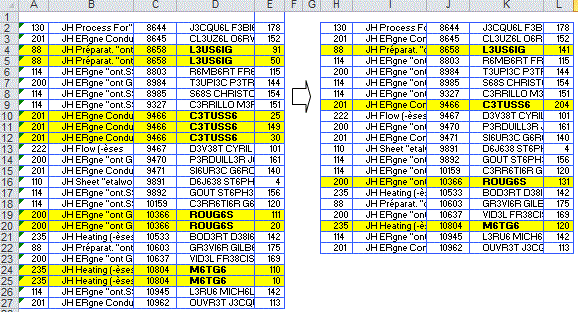
Sub SupDoublonsToutesColTotalisation()
Application.ScreenUpdating = False
Set f1 = Sheets("feuil1")
a = f1.Range("A2").CurrentRegion.Value
Dim c()
ReDim c(1 To UBound(a, 1), 1 To UBound(a, 2))
ligne = 1
Set mondico = CreateObject("Scripting.Dictionary")
For i = 1 To UBound(a)
temp = ""
For k = 1 To UBound(a, 2) - 1: temp = temp &
a(i, k): Next
If Not mondico.exists(temp) Then
mondico.Add temp, ligne
For k = 1 To UBound(a, 2): c(ligne,
k) = a(i, k): Next k
ligne = ligne + 1
Else
lig = mondico.Item(temp)
c(lig, UBound(a, 2)) = c(lig, UBound(a,
2)) + a(i, UBound(a, 2))
End If
Next
f1.[H2].Resize(mondico.Count, UBound(a, 2)) = c
End Sub
Nombre d'occurences des doublons
On veut classer les doublons par ordre du nombre d'occurences.
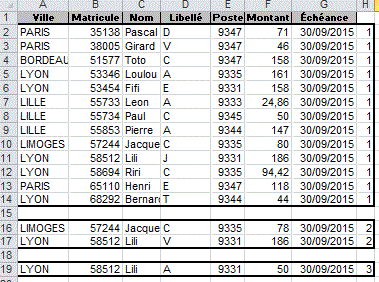
Sub DoublonsOccurence()
a = Range("A2:H" & [A65000].End(xlUp).Row).Value
Set d = CreateObject("scripting.dictionary")
For i = LBound(a) To UBound(a)
d(CStr(a(i, 2))) = d(CStr(a(i, 2))) + 1
a(i, UBound(a, 2)) = d(CStr(a(i, 2)))
Next i
Set f = Sheets("result")
f.Cells.Clear: [A1:H1].Copy f.[A1]
f.[a2].Resize(UBound(a), UBound(a, 2)) = a
f.[a2].Sort key1:=f.[h2], key2:=f.[b2], Header:=yes
For i = f.[A65000].End(xlUp).Row To 3 Step -1
If f.Cells(i, 8) <> f.Cells(i - 1,
8) Then f.Rows(i).Insert
Next i
Set Rng = f.Range("A2:H" & f.[A65000].End(xlUp).Row).SpecialCells(xlCellTypeConstants)
For i = 1 To Rng.Areas.Count
Rng.Areas(i).BorderAround Weight:=xlMedium
Next i
End Sub
Fonction de suppression de doublons
Fonction suppression doublons BD

Génère des identifiants